Paul Bishop's Blog, page 28
February 25, 2017
ANGEL’S FLIGHT
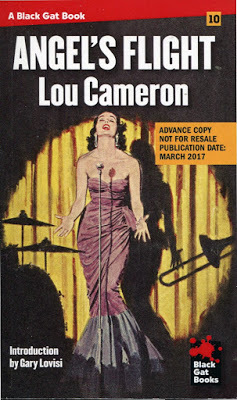 ANGEL’S FLIGHT Fawcett’s Gold Medal paperback original imprint published some of the toughest, leanest, brilliantly plotted, noir and hardboiled novels to ever grace the drugstore spinner racks from the ’50 to the ‘70s. Ornamented with fantastic cover art, Gold Medal paperbacks stand as a legacy from the top authors of a generation. Unfortunately, too many of these novels have been forgotten or lost to time, banished to the tables at paperback collector shows. While they are scarce, a few can still be found in the wild. They haunt the shelves of Goodwill, Salvation Army, and other thrift stores, waiting desperately for somebody who will recognize the power and value of the stories still within their covers. Stark House Press is to be commended for their current Black Gat Books imprint dedicated to bringing back into print some of the best authors from the Gold Medal heydays. Authors such as Harry Whittington, Orrie Hitt, Leigh Bracket, and Vin Packer are names from the past brought back into the public conscious by Black Gat to get their well-deserved due. The latest title from Black Gat is Lou Cameron’s Angel’s Flight. Cameron wrote more than 100 books in his career. Angle’s Flight was his first and it remains a killer of a tale. It’s a crazy ruthless story of the music business told from the inside, from swing jazz to bebop to rock & roll. Angel’s flight is noir at its darkest—desperation on steroids—and a stunning read for anyone who has ever experienced a fascination with the dark side of life. Paperback Parade’sGary Lovisi writes the introduction to this volume stating, Angel’s Flight sings loud and true with terrific characters, real heart and is a joy to read…a noir masterpiece. He’s absolutely right…read it now…
ANGEL’S FLIGHT Fawcett’s Gold Medal paperback original imprint published some of the toughest, leanest, brilliantly plotted, noir and hardboiled novels to ever grace the drugstore spinner racks from the ’50 to the ‘70s. Ornamented with fantastic cover art, Gold Medal paperbacks stand as a legacy from the top authors of a generation. Unfortunately, too many of these novels have been forgotten or lost to time, banished to the tables at paperback collector shows. While they are scarce, a few can still be found in the wild. They haunt the shelves of Goodwill, Salvation Army, and other thrift stores, waiting desperately for somebody who will recognize the power and value of the stories still within their covers. Stark House Press is to be commended for their current Black Gat Books imprint dedicated to bringing back into print some of the best authors from the Gold Medal heydays. Authors such as Harry Whittington, Orrie Hitt, Leigh Bracket, and Vin Packer are names from the past brought back into the public conscious by Black Gat to get their well-deserved due. The latest title from Black Gat is Lou Cameron’s Angel’s Flight. Cameron wrote more than 100 books in his career. Angle’s Flight was his first and it remains a killer of a tale. It’s a crazy ruthless story of the music business told from the inside, from swing jazz to bebop to rock & roll. Angel’s flight is noir at its darkest—desperation on steroids—and a stunning read for anyone who has ever experienced a fascination with the dark side of life. Paperback Parade’sGary Lovisi writes the introduction to this volume stating, Angel’s Flight sings loud and true with terrific characters, real heart and is a joy to read…a noir masterpiece. He’s absolutely right…read it now…
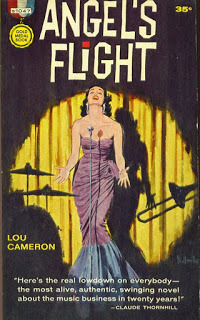
Published on February 25, 2017 17:39
A WRITER’S TREASURE CHEST
 A WRITER’S TREASURE CHEST Every writer should have a treasure chest—a place to store golden nuggets of brilliant ideas, keeping them from being forgotten and giving them a place to mature. Ideas are very different from stories. Stories have a beginning a middle and an end. If a story doesn’t have all three of those elements, it’s a story fragment—not a story. To become a story, an idea often needs to be strung together with other seemingly unrelated ideas before sparking the inspiration to becomes a fully formed story.
A WRITER’S TREASURE CHEST Every writer should have a treasure chest—a place to store golden nuggets of brilliant ideas, keeping them from being forgotten and giving them a place to mature. Ideas are very different from stories. Stories have a beginning a middle and an end. If a story doesn’t have all three of those elements, it’s a story fragment—not a story. To become a story, an idea often needs to be strung together with other seemingly unrelated ideas before sparking the inspiration to becomes a fully formed story.
 For my idea treasure chest, I use cheap composition books—those stiff cover, lined-paged, 9X7 notebooks I used in college (back in the days when dinosaurs roamed the earth). Over the years, I’ve collected a bookshelf’s worth of these invaluable resources. Whenever I am beginning a new writing project of any kind, I plunder these notebooks for inspiration.
For my idea treasure chest, I use cheap composition books—those stiff cover, lined-paged, 9X7 notebooks I used in college (back in the days when dinosaurs roamed the earth). Over the years, I’ve collected a bookshelf’s worth of these invaluable resources. Whenever I am beginning a new writing project of any kind, I plunder these notebooks for inspiration.
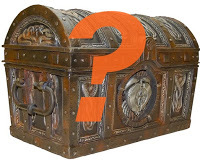 First let me explain what kind of ideas I put in my treasure chest. Recently, I was driving to a writing conference while listening to Weekend Edition on my local NPR station. Before the first hour of the show was finished, I had to pull over and scribble down four ideas sparked by the profiles and interviews to which I’d been listening (you can’t consider yourself a writer if you don’t keep a pen and paper handy at all times). I later transcribed these scribbled notes into my current composition book. What were these ideas? Here are the notes I wrote down:
Food Fraud…Billion dollar industry…Food fingerprints...
A teen molested by her father is forced to pose as dead…Father obsessed with True Crime magazines…Recreates murder scenes using daughter as the corpse...
Faded sit-com star—one of the first Asians to be portrayed in a positive manner despite her soft around the edges body and plain face)—finds she still has an impact on modern youth…Letters sent long after the show is over…Weave in story of how protagonist made her character positive by manipulating the show’s writers…
Italian judge fights organized crime by taking away the children of Mafia families and placing them in foster homes to break the cycle of inherited violence...Some mothers beg the judge to take their children...Many of the fathers in jail...Patriarchal animosity…Judge must be stopped before he destroys the balance of power...
I later added a fifth note for the day after reading a newspaper article:
Failure rate of tasers used by police departments. Jack Cover, the NASA scientist who invented the taser, named the stun gun after his favorite science fiction hero—Tom Swift…TASER: Tomas A. Swift’s Electric Rifle…
None of these ideas pertain to any current work I have in progress. They might never have anything to do with anything I ever write—but they are there if I need them. And now some words from, Alice In Wonderland...
Alice laughed. “There's no use trying,” she said. "One can't believe impossible things."
“I daresay you haven't had much practice,” said the Queen. “When I was your age, I always did it for half-an-hour a day. Why, sometimes I've believed as many as six impossible things before breakfast.”
Why did I choose those lines from Alice and the Queen? Because far too many beginning writers are fearful of having their ideas stolen. What they don’t realize is most established writers give away more ideas before breakfast than a beginning writer comes up with in a month. By the way, feel free to steal any of the above ideas. Why? Because I like you. Actually, I don’t even know you, so that can’t really be the reason. I may like you if we ever become acquainted, but sharing my ideas with you is not dependent on my liking you or not. What I can tell you is even if we took the same idea and began writing at the same time, we would produce totally different stories.
First let me explain what kind of ideas I put in my treasure chest. Recently, I was driving to a writing conference while listening to Weekend Edition on my local NPR station. Before the first hour of the show was finished, I had to pull over and scribble down four ideas sparked by the profiles and interviews to which I’d been listening (you can’t consider yourself a writer if you don’t keep a pen and paper handy at all times). I later transcribed these scribbled notes into my current composition book. What were these ideas? Here are the notes I wrote down:
Food Fraud…Billion dollar industry…Food fingerprints...
A teen molested by her father is forced to pose as dead…Father obsessed with True Crime magazines…Recreates murder scenes using daughter as the corpse...
Faded sit-com star—one of the first Asians to be portrayed in a positive manner despite her soft around the edges body and plain face)—finds she still has an impact on modern youth…Letters sent long after the show is over…Weave in story of how protagonist made her character positive by manipulating the show’s writers…
Italian judge fights organized crime by taking away the children of Mafia families and placing them in foster homes to break the cycle of inherited violence...Some mothers beg the judge to take their children...Many of the fathers in jail...Patriarchal animosity…Judge must be stopped before he destroys the balance of power...
I later added a fifth note for the day after reading a newspaper article:
Failure rate of tasers used by police departments. Jack Cover, the NASA scientist who invented the taser, named the stun gun after his favorite science fiction hero—Tom Swift…TASER: Tomas A. Swift’s Electric Rifle…
None of these ideas pertain to any current work I have in progress. They might never have anything to do with anything I ever write—but they are there if I need them. And now some words from, Alice In Wonderland...
Alice laughed. “There's no use trying,” she said. "One can't believe impossible things."
“I daresay you haven't had much practice,” said the Queen. “When I was your age, I always did it for half-an-hour a day. Why, sometimes I've believed as many as six impossible things before breakfast.”
Why did I choose those lines from Alice and the Queen? Because far too many beginning writers are fearful of having their ideas stolen. What they don’t realize is most established writers give away more ideas before breakfast than a beginning writer comes up with in a month. By the way, feel free to steal any of the above ideas. Why? Because I like you. Actually, I don’t even know you, so that can’t really be the reason. I may like you if we ever become acquainted, but sharing my ideas with you is not dependent on my liking you or not. What I can tell you is even if we took the same idea and began writing at the same time, we would produce totally different stories.
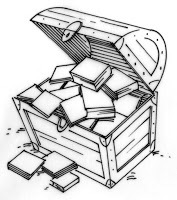 Synesthesia (a neurological phenomenon in which stimulation of one sensory or cognitive pathway leads to automatic, involuntary experiences in a second sensory or cognitive pathway) played a very important part in my novel Lie Catchers. However, the idea of synesthesia had been in my writer’s treasure chest for over ten years. When I flipped through my notebooks in preparation for writing Lie Catchers, I came across my entry on synesthesia and immediately knew I’d found the perfect place to incorporate the idea into a whole story. My notebooks are filled with off the wall ideas. Many of them I may never use, but I know I’ll find a way of using many of the others in future stories. Often two or three ideas from my notebooks end up in one story—usually a novel. Other times, one idea from my notebooks may inspire a short story years after I first jotted it down. Life and our subconscious have a way of giving ideas proper context at the proper time. What’s in your writer’s notebook?
Synesthesia (a neurological phenomenon in which stimulation of one sensory or cognitive pathway leads to automatic, involuntary experiences in a second sensory or cognitive pathway) played a very important part in my novel Lie Catchers. However, the idea of synesthesia had been in my writer’s treasure chest for over ten years. When I flipped through my notebooks in preparation for writing Lie Catchers, I came across my entry on synesthesia and immediately knew I’d found the perfect place to incorporate the idea into a whole story. My notebooks are filled with off the wall ideas. Many of them I may never use, but I know I’ll find a way of using many of the others in future stories. Often two or three ideas from my notebooks end up in one story—usually a novel. Other times, one idea from my notebooks may inspire a short story years after I first jotted it down. Life and our subconscious have a way of giving ideas proper context at the proper time. What’s in your writer’s notebook?

Published on February 25, 2017 16:08
February 16, 2017
THE FANATIC OF OZ
 THE FANATIC OF OZEDITOR JUSTIN MARRIOT COMES OUT FROM BEHINDTHE CURTAIN OF THE PAPERBACK FANATICTO TALK ABOUT GENRE MAGAZINE PUBLISHING The history of fanzines is long and varied, peppered with amateur efforts—some of which verge on illiterate. I too have participated in my share of fanzines, self-publishing both The Thieftaker Journals and Brass Knuckles during my earliest infatuations with genre fiction, especially the men's adventure paperbacks of the ‘70s and ‘80s. The Executioner, the Destroyer, the Penetrator, and many other paperback original series were cranked out during the time period it was hard to keep track of them all. However, since they were considered disposable fiction, very little was written about them, nor was there any exploration of their wide appeal. Occasionally, a publication will rise above the level of fanzine to become a genuine contribution to the genre. One of my first exposure to this level of zine was Hardboiled Magazine, originally created and published by Wayne D. Dundee, which published some of my earliest fiction. Hardboiled Magazine was later continued by Gary Lovisi under his Gryphon Books imprint, which has produced numerous publications of specific interest.
THE FANATIC OF OZEDITOR JUSTIN MARRIOT COMES OUT FROM BEHINDTHE CURTAIN OF THE PAPERBACK FANATICTO TALK ABOUT GENRE MAGAZINE PUBLISHING The history of fanzines is long and varied, peppered with amateur efforts—some of which verge on illiterate. I too have participated in my share of fanzines, self-publishing both The Thieftaker Journals and Brass Knuckles during my earliest infatuations with genre fiction, especially the men's adventure paperbacks of the ‘70s and ‘80s. The Executioner, the Destroyer, the Penetrator, and many other paperback original series were cranked out during the time period it was hard to keep track of them all. However, since they were considered disposable fiction, very little was written about them, nor was there any exploration of their wide appeal. Occasionally, a publication will rise above the level of fanzine to become a genuine contribution to the genre. One of my first exposure to this level of zine was Hardboiled Magazine, originally created and published by Wayne D. Dundee, which published some of my earliest fiction. Hardboiled Magazine was later continued by Gary Lovisi under his Gryphon Books imprint, which has produced numerous publications of specific interest.
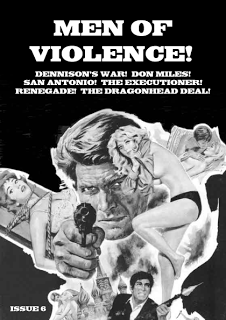 But there is another series of zines I have found to be exactly what I’m looking for when it comes to plumbing the depths of genre fiction. The Paperback Fanatic, Pulp Horror, Sleazy Reader, and especially Men of Violence are all zines published and edited in England by the uber knowledgeable Justin Marriott. All of these zines are dedicated to collecting and sharing knowledge of pulp paperbacks from the ‘60s and ‘70s. Jam-packed with author interviews and articles about the weird and wonderful books from the era, these zines are bursting with previously undocumented information and loaded with reproductions of many rarely seen covers. These zines are all published with limited print runs and have become a valuable commodity for true collectors of the genre. Back issues are often sold out and hard to find through the usual secondhand book and magazine sites.
But there is another series of zines I have found to be exactly what I’m looking for when it comes to plumbing the depths of genre fiction. The Paperback Fanatic, Pulp Horror, Sleazy Reader, and especially Men of Violence are all zines published and edited in England by the uber knowledgeable Justin Marriott. All of these zines are dedicated to collecting and sharing knowledge of pulp paperbacks from the ‘60s and ‘70s. Jam-packed with author interviews and articles about the weird and wonderful books from the era, these zines are bursting with previously undocumented information and loaded with reproductions of many rarely seen covers. These zines are all published with limited print runs and have become a valuable commodity for true collectors of the genre. Back issues are often sold out and hard to find through the usual secondhand book and magazine sites.
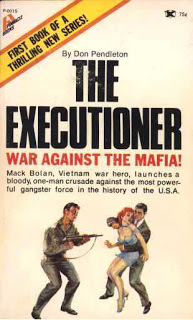 The current six issue run of Men of Violence is Justin Marriott’s latest venture into the documenting of genre fiction. Alongside his mothership zine, The Paperback Fanatic, Men of Violence examines everything from the most successful paperback series of the era—including Don Pendleton's Executioner, Stuart Jason's Butcher, and Paul Edwards' John Eagle: Expeditor—to many lesser known series, including a number that were the pseudonymous training grounds for some of today’s bestselling authors—who would often prefer to have these early effort kicked into a dark dungeon and ignored.
The current six issue run of Men of Violence is Justin Marriott’s latest venture into the documenting of genre fiction. Alongside his mothership zine, The Paperback Fanatic, Men of Violence examines everything from the most successful paperback series of the era—including Don Pendleton's Executioner, Stuart Jason's Butcher, and Paul Edwards' John Eagle: Expeditor—to many lesser known series, including a number that were the pseudonymous training grounds for some of today’s bestselling authors—who would often prefer to have these early effort kicked into a dark dungeon and ignored.
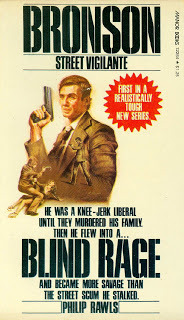 There are also articles on some of the cut rate paperback publishing houses of the day, who frequently ground out these series as quickly as possible to maximize profits. One example is Manor Books, which published some of the genre's sleaziest series, including Kill Squad, Bronson, and Kung Fu starring Mace. Other examples include genre legend Peter McCurtin's long running Marksman series from Belmont Tower, and many adult western series from the king publisher of paperback original, Pinnacle Books. Justin also liberally splashes black and white reproductions throughout his zines of the startling cover art—the sizzle on the outside that sold the often unfulfilled promise on the inside—which is an integral part of the men’s adventure paperback genre. To many collectors, the focus on these covers and their artists is of equal importance, sometimes more so, than the stories beneath the covers. A somewhat reticent and unassuming personality, Justin Marriott has agreed to give us a glimpse behind the scenes of his mini-publishing empire, the books he chooses to highlight, and his thought process behind short print runs and the importance of his end product. This is a big deal for those of us who admire his publications. It isn’t often the Wizard of Genre speaks out, preferring to allow his work to usually speak for itself—which it does...loudly. ********Justin, would you be willing to reveal a few personal details about your background and your world? Paul, thanks for the kind words about my fanzines and the Oz analogy, but I can’t help but think that at the climax of Wizard of Oz, when the curtain is pulled back, the Wizard is revealed as a fraud rather than some all-powerful and all-seeing deity...I suspect this interview may well lead the reader to a similar conclusion. I’m a pretty average Joe, late 40s, married with two young daughters and living in a coastal town in the West of England called Portishead (yes, the famous band comes from these parts). The day job is for a large financial organization where I work in a project team focused on the Digital arm of the company. I was seriously ill with cancer in my late 30s, which was something of wake-up call and made me re-focus on what was important to me. So my spare time is split between my family, trying to keep fit (I tried taking up boxing last year, but getting my ribs broken just before Xmas, whilst sparring with someone who knew what they were doing, soon put a stop to that), and of course, producing my fanzines. What was your first exposure to genre fiction?
There are also articles on some of the cut rate paperback publishing houses of the day, who frequently ground out these series as quickly as possible to maximize profits. One example is Manor Books, which published some of the genre's sleaziest series, including Kill Squad, Bronson, and Kung Fu starring Mace. Other examples include genre legend Peter McCurtin's long running Marksman series from Belmont Tower, and many adult western series from the king publisher of paperback original, Pinnacle Books. Justin also liberally splashes black and white reproductions throughout his zines of the startling cover art—the sizzle on the outside that sold the often unfulfilled promise on the inside—which is an integral part of the men’s adventure paperback genre. To many collectors, the focus on these covers and their artists is of equal importance, sometimes more so, than the stories beneath the covers. A somewhat reticent and unassuming personality, Justin Marriott has agreed to give us a glimpse behind the scenes of his mini-publishing empire, the books he chooses to highlight, and his thought process behind short print runs and the importance of his end product. This is a big deal for those of us who admire his publications. It isn’t often the Wizard of Genre speaks out, preferring to allow his work to usually speak for itself—which it does...loudly. ********Justin, would you be willing to reveal a few personal details about your background and your world? Paul, thanks for the kind words about my fanzines and the Oz analogy, but I can’t help but think that at the climax of Wizard of Oz, when the curtain is pulled back, the Wizard is revealed as a fraud rather than some all-powerful and all-seeing deity...I suspect this interview may well lead the reader to a similar conclusion. I’m a pretty average Joe, late 40s, married with two young daughters and living in a coastal town in the West of England called Portishead (yes, the famous band comes from these parts). The day job is for a large financial organization where I work in a project team focused on the Digital arm of the company. I was seriously ill with cancer in my late 30s, which was something of wake-up call and made me re-focus on what was important to me. So my spare time is split between my family, trying to keep fit (I tried taking up boxing last year, but getting my ribs broken just before Xmas, whilst sparring with someone who knew what they were doing, soon put a stop to that), and of course, producing my fanzines. What was your first exposure to genre fiction?
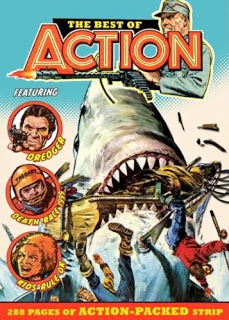 I was a voracious reader from an early age, especially of comics, a habit I inherited from my dad. He would buy the UK weeklies, which repackaged US Marvel material such as Hulk and Spider-Man. He read them on his lunch-hour whilst doing his job of repairing TV sets. I would raid his van and steal these whenever I got the chance. He would also buy me UK originated comics, of which two titles were hugely influential in shaping my outlook as an adult—Action (no, not the DC one) and 2000 AD.
I was a voracious reader from an early age, especially of comics, a habit I inherited from my dad. He would buy the UK weeklies, which repackaged US Marvel material such as Hulk and Spider-Man. He read them on his lunch-hour whilst doing his job of repairing TV sets. I would raid his van and steal these whenever I got the chance. He would also buy me UK originated comics, of which two titles were hugely influential in shaping my outlook as an adult—Action (no, not the DC one) and 2000 AD.
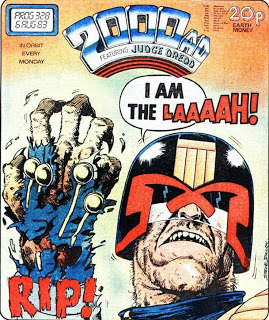 I guess some of your readers may be familiar with 2000 AD in which Judge Dredd was the lead character? Beyond Dredd, the early issues were extremely anarchic, filled with dark humour and satire, and illustrated with free-wheeling art owing more to the European school of illustration than the normal staid approach seen in most UK comics. People of my generation will talk about 2000 AD in the way American teenagers of the 1950s talk about the early Mad magazine. To continue with your Wizard of Oz analogy, 2000 AD pulled back the curtain on authority figures, celebrities, and TV advertising.
I guess some of your readers may be familiar with 2000 AD in which Judge Dredd was the lead character? Beyond Dredd, the early issues were extremely anarchic, filled with dark humour and satire, and illustrated with free-wheeling art owing more to the European school of illustration than the normal staid approach seen in most UK comics. People of my generation will talk about 2000 AD in the way American teenagers of the 1950s talk about the early Mad magazine. To continue with your Wizard of Oz analogy, 2000 AD pulled back the curtain on authority figures, celebrities, and TV advertising.
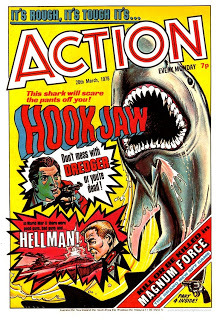 I can’t imagine Actionwill be even remotely familiar to your readers, but for UK readers it will be remembered as a comic banned by the authorities. Decades after the ‘seduction of the innocent’ scandal in the US, which saw horror comics banned, the UK had its own equivalent. A predecessor to 2000 AD, Action was a short-lived adventure comic in the mid-70s, which carried serial strips the writers based on the templates of successful films—many with ratings the readers of Action were too young to see them at the cinema (this was before the age of video).
I can’t imagine Actionwill be even remotely familiar to your readers, but for UK readers it will be remembered as a comic banned by the authorities. Decades after the ‘seduction of the innocent’ scandal in the US, which saw horror comics banned, the UK had its own equivalent. A predecessor to 2000 AD, Action was a short-lived adventure comic in the mid-70s, which carried serial strips the writers based on the templates of successful films—many with ratings the readers of Action were too young to see them at the cinema (this was before the age of video).
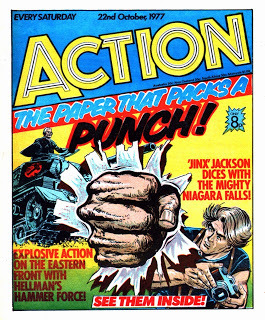 The comic contained thinly-disguised versions of Dirty Harry, Rollerball, and Jaws to name but a few. Hook-Jaw (guess which film this riffed on) in particular, was super-gory, with gnawed-off limbs, shredded heads, and exploding bodies regularly depicted. The shark was the anti-hero. Action’s anti-establishment ethos was punk rock in the form of a black and white comic.
The comic contained thinly-disguised versions of Dirty Harry, Rollerball, and Jaws to name but a few. Hook-Jaw (guess which film this riffed on) in particular, was super-gory, with gnawed-off limbs, shredded heads, and exploding bodies regularly depicted. The shark was the anti-hero. Action’s anti-establishment ethos was punk rock in the form of a black and white comic.
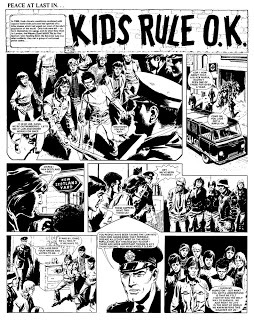 The publishers hated it, but kept it going despite negative coverage in the news (It was described as the “seven-penny nightmare” by a leading newspaper) because of its huge sales volumes. However, one strip in particular, Kids Rule OK—a post-apocalyptic version of Lord of the Flies—bought it all crashing down. The offending issue carried an image of a chain-swinging teenager standing over a cowering figure with a policeman’s helmet in the fore-ground. The publishers had no choice but to act and immediately withdrew the comic. One of my earliest memories is being told by the newsstand owner my comic had been banned. As an eight-year old, I couldn’t grasp this concept, but it was instrumental in planting an anti-authoritarian seed in my brain.
The publishers hated it, but kept it going despite negative coverage in the news (It was described as the “seven-penny nightmare” by a leading newspaper) because of its huge sales volumes. However, one strip in particular, Kids Rule OK—a post-apocalyptic version of Lord of the Flies—bought it all crashing down. The offending issue carried an image of a chain-swinging teenager standing over a cowering figure with a policeman’s helmet in the fore-ground. The publishers had no choice but to act and immediately withdrew the comic. One of my earliest memories is being told by the newsstand owner my comic had been banned. As an eight-year old, I couldn’t grasp this concept, but it was instrumental in planting an anti-authoritarian seed in my brain.
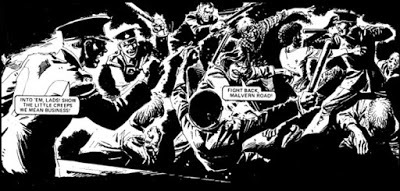 Like most boys of my age, I grew up a huge fan of the UK TV program Dr Who. I would think the novelizations of Doctor Who were the first genre books I encountered. These were in the form of hardbacks loaned from the local library. I would read them cover to cover in a day. Even at that early age, I started to identify which authors I preferred—with Terrence Dicks, the creator of the Daleks, being a favourite. The cover art, stippled and dynamic images from Chris Achilleos, such as a pterodactyl with a Kklak! sound effect, were also very attractive to me.
Like most boys of my age, I grew up a huge fan of the UK TV program Dr Who. I would think the novelizations of Doctor Who were the first genre books I encountered. These were in the form of hardbacks loaned from the local library. I would read them cover to cover in a day. Even at that early age, I started to identify which authors I preferred—with Terrence Dicks, the creator of the Daleks, being a favourite. The cover art, stippled and dynamic images from Chris Achilleos, such as a pterodactyl with a Kklak! sound effect, were also very attractive to me.
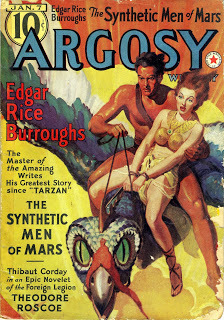 There was a big, out-of-town discount superstore my parents would take me and my younger brother to in the ‘70s. It was an asbestos riddled maze, which included a large stationery department with several spinner-rack of paperbacks. These boasted the distinctive saw-cut in the edges to show they were warehouse remainders, and sold at less than cover price. We would be given our pocket-money and then spend hours choosing pens and paper (with which to draw our own comics) and perusing the paperbacks. I remember buying New English Library editions of Edgar Rice Burroughs, specifically Tarzan and Synthetic Men of Mars. The latter, I found tremendously exciting to read with hero John Carter trapped in the body of one of the synthetic men and taking part in gladiatorial battles.
There was a big, out-of-town discount superstore my parents would take me and my younger brother to in the ‘70s. It was an asbestos riddled maze, which included a large stationery department with several spinner-rack of paperbacks. These boasted the distinctive saw-cut in the edges to show they were warehouse remainders, and sold at less than cover price. We would be given our pocket-money and then spend hours choosing pens and paper (with which to draw our own comics) and perusing the paperbacks. I remember buying New English Library editions of Edgar Rice Burroughs, specifically Tarzan and Synthetic Men of Mars. The latter, I found tremendously exciting to read with hero John Carter trapped in the body of one of the synthetic men and taking part in gladiatorial battles. 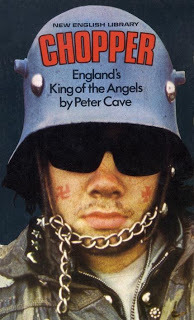 The first book I remember being passed around at school, like dog-eared contraband in a prison camp handed over with a conspiratorial nod and a wink, was Chopper, another New English Library book. This outlaw-biker classic was first published in 1971, but I’m talking about 1979 when I was ten, so it’s little wonder it was held together by Sellotape and spit after so many years in circulation. A biker version of Macbeth, replete with explicit sex and violence, it was entirely inappropriate for a ten-year old, which is exactly why it was so wonderful. Decades later, I discovered the author of Chopper had lived around the corner from me for many years.
The first book I remember being passed around at school, like dog-eared contraband in a prison camp handed over with a conspiratorial nod and a wink, was Chopper, another New English Library book. This outlaw-biker classic was first published in 1971, but I’m talking about 1979 when I was ten, so it’s little wonder it was held together by Sellotape and spit after so many years in circulation. A biker version of Macbeth, replete with explicit sex and violence, it was entirely inappropriate for a ten-year old, which is exactly why it was so wonderful. Decades later, I discovered the author of Chopper had lived around the corner from me for many years.
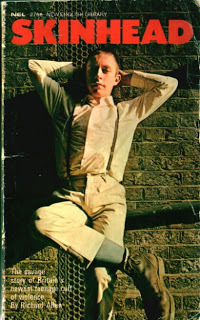 A similar youth-cult book was Skinhead, which on top of the sex and violence was deeply racist. When my parents found it and flicked through it, they disapproved and made me donate it to a yard-sale. My parents were very liberal, allowing me to watch Hammer horror films and turning a blind eye to my girlie magazine collection (a few years later), so I knew the book must have been bad for them to confiscate it. I wonder if my whole path of a life in pursuit of rare and unusual paperbacks was mapped out at this point. I bought Skinhead at Read ‘n Return, a used book store which made its money from the huge selection of skin-mags displayed at the back of the shop—off-limits to the likes of me. It was guarded by a grizzled Alsatian dog the size of a bear. Although the owner was cool, I later heard he sold all sorts of highly dubious material under-the-counter. He also stocked comics, which is why I had started to frequent the place. He would give you half back on your purchase price if you returned the comics for re-sale. The boxes of older returned comics were an absolute treasure-trove to any teenager on a budget.
A similar youth-cult book was Skinhead, which on top of the sex and violence was deeply racist. When my parents found it and flicked through it, they disapproved and made me donate it to a yard-sale. My parents were very liberal, allowing me to watch Hammer horror films and turning a blind eye to my girlie magazine collection (a few years later), so I knew the book must have been bad for them to confiscate it. I wonder if my whole path of a life in pursuit of rare and unusual paperbacks was mapped out at this point. I bought Skinhead at Read ‘n Return, a used book store which made its money from the huge selection of skin-mags displayed at the back of the shop—off-limits to the likes of me. It was guarded by a grizzled Alsatian dog the size of a bear. Although the owner was cool, I later heard he sold all sorts of highly dubious material under-the-counter. He also stocked comics, which is why I had started to frequent the place. He would give you half back on your purchase price if you returned the comics for re-sale. The boxes of older returned comics were an absolute treasure-trove to any teenager on a budget.
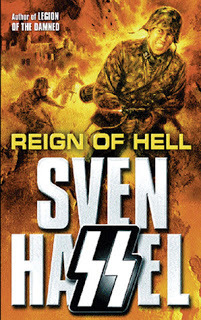 I purchased my first book outside of my parent’s supervision there—Reign of Hell by Sven Hassel. I have no idea how I knew about this book, but it was part of a fifteen-odd book series purportedly based on true events surrounding a German penal regiment. With a colourful gallery of rogues, a strange mish-mash of extreme gore and anti-war preaching, this was the book I fervently pushed into other kid’s hands. It spawned a whole genre in the UK, with any number of English authors adopting Germanic pseudonyms to tell their own gritty stories of German Stormtroopers, with Leo Kessler being the most successful example.
I purchased my first book outside of my parent’s supervision there—Reign of Hell by Sven Hassel. I have no idea how I knew about this book, but it was part of a fifteen-odd book series purportedly based on true events surrounding a German penal regiment. With a colourful gallery of rogues, a strange mish-mash of extreme gore and anti-war preaching, this was the book I fervently pushed into other kid’s hands. It spawned a whole genre in the UK, with any number of English authors adopting Germanic pseudonyms to tell their own gritty stories of German Stormtroopers, with Leo Kessler being the most successful example.
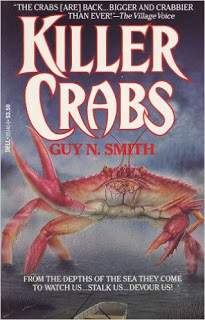 The first brand-new, full price book I can recollect buying was Killer Crabs by Guy Smith, whose pulp horror novels are something of a cult to this day. It’s became popular to knock Smith, but his books were very commercially successful and exactly what any morbid and horny teenager was looking for as a slim but outrageous read. I bought it from Woolworths whilst on a family caravanning holiday along the South coast of England. After a day on the beach, I would read it before bed, and can still remember the feel of the sleeping-bag against my sun-burned arms. Strange what memories and associations we carry with us. Throughout this time, I never kept the books I read. I saw them as disposable, taking them back to the Read n Return or to swap with friends. It’s only been in the last 15 years I’ve proactively begun to collect and accumulate paperbacks. However, I may keep the books (I own in excess of 15,000 paperbacks), but I take little care of them. People expect me to have them stored in Mylar bags and filed away in alphabetical order, but the reality is they are randomly piled up in my garage, which always causes me a giant headache whenever I try to locate a particular title amongst the chaos. I will often read a book in the bath, which will typically end up dog-eared and/or dropped in the water. Right now we are planning to move house, and most of my books have been boxed up for the best part of 6 months. The garage looks like a low-budget version of the warehouse in the final scene from Raiders of the Lost Ark. What made you decide to start your first zine and with what goal?
The first brand-new, full price book I can recollect buying was Killer Crabs by Guy Smith, whose pulp horror novels are something of a cult to this day. It’s became popular to knock Smith, but his books were very commercially successful and exactly what any morbid and horny teenager was looking for as a slim but outrageous read. I bought it from Woolworths whilst on a family caravanning holiday along the South coast of England. After a day on the beach, I would read it before bed, and can still remember the feel of the sleeping-bag against my sun-burned arms. Strange what memories and associations we carry with us. Throughout this time, I never kept the books I read. I saw them as disposable, taking them back to the Read n Return or to swap with friends. It’s only been in the last 15 years I’ve proactively begun to collect and accumulate paperbacks. However, I may keep the books (I own in excess of 15,000 paperbacks), but I take little care of them. People expect me to have them stored in Mylar bags and filed away in alphabetical order, but the reality is they are randomly piled up in my garage, which always causes me a giant headache whenever I try to locate a particular title amongst the chaos. I will often read a book in the bath, which will typically end up dog-eared and/or dropped in the water. Right now we are planning to move house, and most of my books have been boxed up for the best part of 6 months. The garage looks like a low-budget version of the warehouse in the final scene from Raiders of the Lost Ark. What made you decide to start your first zine and with what goal?
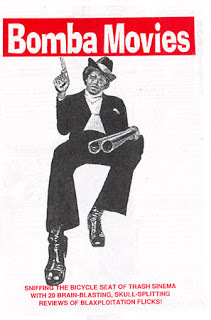 From a young age, I always produced comics and fanzines. However, the first I printed in any quantity and distributed was in the late 1990s. Bomba Movies was dedicated to reviews of exploitation movies. It lasted seven issues, of which the first six were free of charge to anyone sending me a SAE (stamped and addressed envelope).
From a young age, I always produced comics and fanzines. However, the first I printed in any quantity and distributed was in the late 1990s. Bomba Movies was dedicated to reviews of exploitation movies. It lasted seven issues, of which the first six were free of charge to anyone sending me a SAE (stamped and addressed envelope).
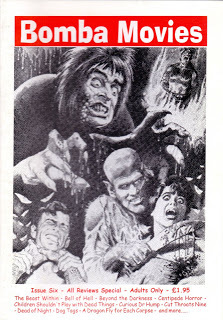 At this point in time, there was an active underground in the UK trading and duplicating horror video tapes, which were not legally available. This trend resulted in a hot-bed of related, photo-copied, fanzines springing into existence. These were mostly dedicated to European horror films, which were often viewed as grainy fifth-generation bootlegs, or in foreign language from being picked up on holidays in Greece or Italy. Many of the fanzines were little more than plot summaries focused on descriptions of the goriest scenes. They also covered the same old films over and over with little insight or originality.
At this point in time, there was an active underground in the UK trading and duplicating horror video tapes, which were not legally available. This trend resulted in a hot-bed of related, photo-copied, fanzines springing into existence. These were mostly dedicated to European horror films, which were often viewed as grainy fifth-generation bootlegs, or in foreign language from being picked up on holidays in Greece or Italy. Many of the fanzines were little more than plot summaries focused on descriptions of the goriest scenes. They also covered the same old films over and over with little insight or originality.
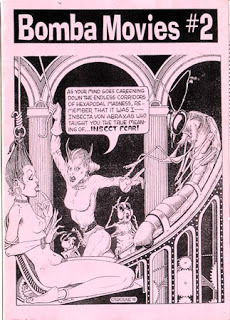 Bomba Movies was intended as a riposte to these. It was intentionally crude and opinionated, with a collage layout of comic panels and movies posters juxtaposed with speech bubbles and headlines from other sources. It was more in line with punk rock fanzines, but without the politics. It was also important to me not to charge for the zine. It cost me about £50 to run off a hundred copies, which as a single man was something I was happy to write off. I look back now and cringe at the humor, but at the time it gained something of a cult following due to its attitude.
Bomba Movies was intended as a riposte to these. It was intentionally crude and opinionated, with a collage layout of comic panels and movies posters juxtaposed with speech bubbles and headlines from other sources. It was more in line with punk rock fanzines, but without the politics. It was also important to me not to charge for the zine. It cost me about £50 to run off a hundred copies, which as a single man was something I was happy to write off. I look back now and cringe at the humor, but at the time it gained something of a cult following due to its attitude.
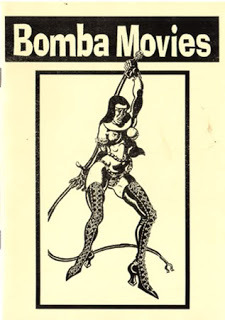 It’s difficult to summarize in a paragraph, but at the time ‘video nasties’ were the bete-noir of the UK tabloid press. They were often blamed for some terrible copy-cat crimes, and anyone owning copies was running the risk of a dawn-raid by Trading Standards and the Police. This may seem like exaggeration, especially now when you can probably buy a director’s cut DVD of Cannibal Holocaust from Amazon. However, in the hysterical atmosphere in the UK of the day, you could get arrested for owning a copy. The editor of the most popular UK horror film fanzine, Samhain, lost his job as a nursery assistant when the local paper ran an ‘expose’ on him and his literate and considered publication.
It’s difficult to summarize in a paragraph, but at the time ‘video nasties’ were the bete-noir of the UK tabloid press. They were often blamed for some terrible copy-cat crimes, and anyone owning copies was running the risk of a dawn-raid by Trading Standards and the Police. This may seem like exaggeration, especially now when you can probably buy a director’s cut DVD of Cannibal Holocaust from Amazon. However, in the hysterical atmosphere in the UK of the day, you could get arrested for owning a copy. The editor of the most popular UK horror film fanzine, Samhain, lost his job as a nursery assistant when the local paper ran an ‘expose’ on him and his literate and considered publication.
 I gave it up when a correspondent who ran a fanzine mail-order distribution service told me the police had visited him and when they saw Bomba Movies immediately identified it as a “snuff movie catalogue” and wanted to know where it came from! He never coughed my name up, but I would have lost my job if I had been associated with the debacle. As a result, I immediately destroyed my video collection and stopped publishing. What has been the reception to The Paperback Fanaticand how has its focus changed over the course of 36 issues?
I gave it up when a correspondent who ran a fanzine mail-order distribution service told me the police had visited him and when they saw Bomba Movies immediately identified it as a “snuff movie catalogue” and wanted to know where it came from! He never coughed my name up, but I would have lost my job if I had been associated with the debacle. As a result, I immediately destroyed my video collection and stopped publishing. What has been the reception to The Paperback Fanaticand how has its focus changed over the course of 36 issues?
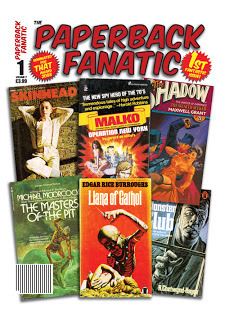 I originally published The Paperback Fanatic back in 2007 because no-one else was publishing anything like it. Although a regular reader, I had spent the previous decades collecting horror fanzines and comics. My paperback reading was mainly modern crime authors such as James Elroy and Andrew Vachss. Whilst browsing the book section of a charity shop, I stumbled across a handful of New English Library outlaw biker paperbacks, which I had so avidly read in the 1970s. I purchased them all. I then began searching for information on the publisher and the authors. I expected to find these paperback gems to be well documented in the same way as genre films and comics of the era—with books, web-sites, and magazines dedicated to them. There were none, so I felt I had no choice but to start another fanzine, this time focused on the UK paperbacks I had grown up reading in the 1970s.
I originally published The Paperback Fanatic back in 2007 because no-one else was publishing anything like it. Although a regular reader, I had spent the previous decades collecting horror fanzines and comics. My paperback reading was mainly modern crime authors such as James Elroy and Andrew Vachss. Whilst browsing the book section of a charity shop, I stumbled across a handful of New English Library outlaw biker paperbacks, which I had so avidly read in the 1970s. I purchased them all. I then began searching for information on the publisher and the authors. I expected to find these paperback gems to be well documented in the same way as genre films and comics of the era—with books, web-sites, and magazines dedicated to them. There were none, so I felt I had no choice but to start another fanzine, this time focused on the UK paperbacks I had grown up reading in the 1970s.
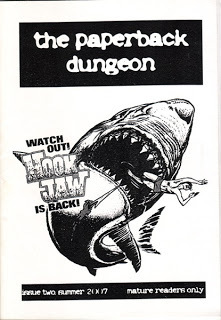 My first attempt took the form of The Paperback Dungeon, which was 32 pages A4, run off on a photo-copier and available for a SAE. I immediately noticed people connected with this zine in a way they hadn’t with my previous publications. It also elicited some very personal responses. I also began to collect paperbacks—as used bookstores began their decline—which was much cheaper than collecting comics, and less dangerous than collecting bootlegs of horror films.
My first attempt took the form of The Paperback Dungeon, which was 32 pages A4, run off on a photo-copier and available for a SAE. I immediately noticed people connected with this zine in a way they hadn’t with my previous publications. It also elicited some very personal responses. I also began to collect paperbacks—as used bookstores began their decline—which was much cheaper than collecting comics, and less dangerous than collecting bootlegs of horror films.
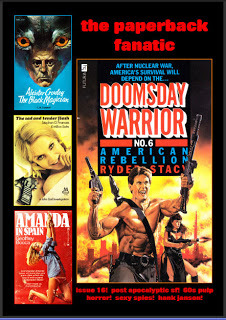 When I launched The Paperback Fanatic, I was single with large amounts of free time for research and travel. The early issues contained interviews with authors and artists responsible for my favourite vintage paperbacks, as well as lengthy and comprehensive articles which I re-wrote again and again. Looking at more recent issues, my contributions are one or two per issue, more general overviews and certainly no interviews.
When I launched The Paperback Fanatic, I was single with large amounts of free time for research and travel. The early issues contained interviews with authors and artists responsible for my favourite vintage paperbacks, as well as lengthy and comprehensive articles which I re-wrote again and again. Looking at more recent issues, my contributions are one or two per issue, more general overviews and certainly no interviews.
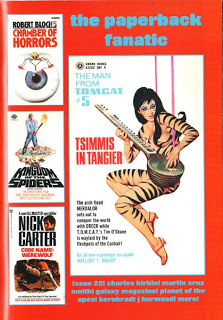 Part of the reaction to the zine has been the number of quality of reliable contributors who have stepped up to provide content. I’m almost guaranteed to have three-quarters of any issue written by the crew. I couldn’t produce the zines on such a regular basis without them. Quite often, I’ll be in a rut, but receiving a contribution from one of the crews will inspire me, or create a spark, resulting in an issue taking shape.
Part of the reaction to the zine has been the number of quality of reliable contributors who have stepped up to provide content. I’m almost guaranteed to have three-quarters of any issue written by the crew. I couldn’t produce the zines on such a regular basis without them. Quite often, I’ll be in a rut, but receiving a contribution from one of the crews will inspire me, or create a spark, resulting in an issue taking shape.
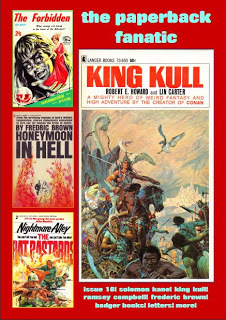 The vast majority of the readership is silent. I used to find this frustrating, but accept nobody will feel as passionately about your zine as you do. As the zine has chugged along for a decade, people see it as permanent and therefore tend not to get as excited as they did about those early issues. Why did you decide to start other more specific zines such as Pulp Horror and Sleazy Reader? Two very different motivations, but ultimately both of these genres tend to attract a number of fans not interested in other genres of paperback fiction.
The vast majority of the readership is silent. I used to find this frustrating, but accept nobody will feel as passionately about your zine as you do. As the zine has chugged along for a decade, people see it as permanent and therefore tend not to get as excited as they did about those early issues. Why did you decide to start other more specific zines such as Pulp Horror and Sleazy Reader? Two very different motivations, but ultimately both of these genres tend to attract a number of fans not interested in other genres of paperback fiction.
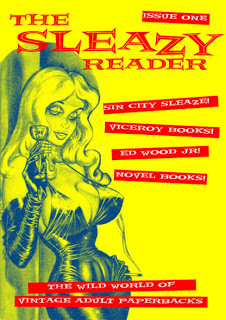 I was a late-comer to sleaze paperbacks, having been turned onto their dubious charms a few years ago by a New York based correspondent. He has a mind-boggling collection of books and original art, and whose support was a motivating factor in getting Sleazy Reader off the ground. When I started to cover sleaze in the pages of The Paperback Fanatic, the reader feedback was mixed. UK readers in particular were unimpressed, so I thought it required its own dedicated title.
I was a late-comer to sleaze paperbacks, having been turned onto their dubious charms a few years ago by a New York based correspondent. He has a mind-boggling collection of books and original art, and whose support was a motivating factor in getting Sleazy Reader off the ground. When I started to cover sleaze in the pages of The Paperback Fanatic, the reader feedback was mixed. UK readers in particular were unimpressed, so I thought it required its own dedicated title.
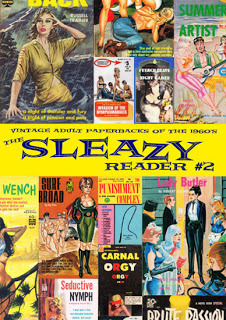 Although I am talking generally, interest in sleaze collecting is bigger in the US than UK. I also find sleaze collectors are not necessarily interested in other paperback genres. If I was to guess, I would say sleaze is less anchored to the format of the paperback and being more focused on the visuals. This would make sleaze paperbacks more closely related to vintage pin-up mags, grind-house movies, and burlesque, than other paperback genres. I believe it also explains why sleaze paperbacks fetch the highest prices of collectible paperbacks, as a much wider audience than typical are bidding for them.
Although I am talking generally, interest in sleaze collecting is bigger in the US than UK. I also find sleaze collectors are not necessarily interested in other paperback genres. If I was to guess, I would say sleaze is less anchored to the format of the paperback and being more focused on the visuals. This would make sleaze paperbacks more closely related to vintage pin-up mags, grind-house movies, and burlesque, than other paperback genres. I believe it also explains why sleaze paperbacks fetch the highest prices of collectible paperbacks, as a much wider audience than typical are bidding for them.
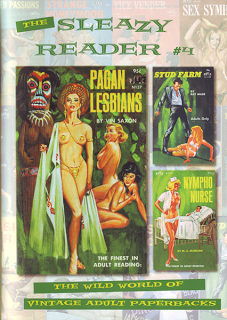 Initially, I had planned it to be small scale—intentionally lo-fi in black and white with crude lay-outs. However, as I developed the first issue, I realized the appeal of the genre is so visual, so full color treatment was needed. In the first couple of issues, I did try to cover the contents of the books, but this was a thankless task. In my experience there is little in the way of unpolished diamonds to be found in the annals of sleaze publishers.
Initially, I had planned it to be small scale—intentionally lo-fi in black and white with crude lay-outs. However, as I developed the first issue, I realized the appeal of the genre is so visual, so full color treatment was needed. In the first couple of issues, I did try to cover the contents of the books, but this was a thankless task. In my experience there is little in the way of unpolished diamonds to be found in the annals of sleaze publishers.
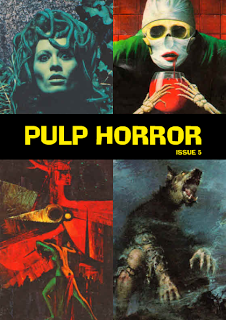 Pulp Horror was my own reaction to The Paperback Fanaticbeing more about checklists and overviews of entire genres or publishers, while lacking in details about individual books. There is an excellent blog called Too Much Horror Fiction, which is comprised of detailed and comprehensive reviews. The first issue of Pulp Horror was my attempt to replicate this format. But with issue #5—100 pages, full color and with a book-spine—the zine has morphed into a horror focused version of The Paperback Fanatic. I’m a fanatic for your latest outing Men of Violence. What made you decide the genre needed a specialty zine?
Pulp Horror was my own reaction to The Paperback Fanaticbeing more about checklists and overviews of entire genres or publishers, while lacking in details about individual books. There is an excellent blog called Too Much Horror Fiction, which is comprised of detailed and comprehensive reviews. The first issue of Pulp Horror was my attempt to replicate this format. But with issue #5—100 pages, full color and with a book-spine—the zine has morphed into a horror focused version of The Paperback Fanatic. I’m a fanatic for your latest outing Men of Violence. What made you decide the genre needed a specialty zine?
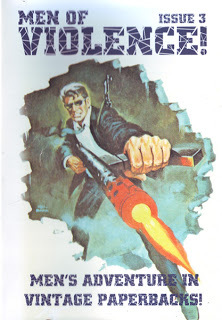 Of all the fanzines I produce, Men of Violence is the fastest and loosest. I tend to write it very quickly, with little in the way of revisions, and have a lot of fun with it. Which is funny, as I hated the men’s adventure genre when I was reading back in the 80s. I saw it as formulaic, right-wing and pro-gun and very much at odds with my personal politics, which were clearly informed by punk music—oh, to be young and idealistic again.
Of all the fanzines I produce, Men of Violence is the fastest and loosest. I tend to write it very quickly, with little in the way of revisions, and have a lot of fun with it. Which is funny, as I hated the men’s adventure genre when I was reading back in the 80s. I saw it as formulaic, right-wing and pro-gun and very much at odds with my personal politics, which were clearly informed by punk music—oh, to be young and idealistic again.
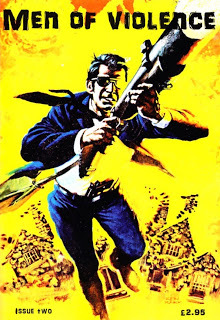 As I started seriously collecting vintage paperbacks, I gradually became attracted to the genre because of the very reasons I hated it a decade or two earlier. The shocking politics and violence. which made the books so outrageous and unpalatable to the majority of readers, meant they were just calling out for their own zine publication. And the collector in me was also attracted to the challenge of collecting numbered series and unravelling the true identity of the authors behind the pseudonyms. There are often questions and misunderstandings regarding the small print runs of your zines. What is your publishing philosophy and the goals you have for your publications?
As I started seriously collecting vintage paperbacks, I gradually became attracted to the genre because of the very reasons I hated it a decade or two earlier. The shocking politics and violence. which made the books so outrageous and unpalatable to the majority of readers, meant they were just calling out for their own zine publication. And the collector in me was also attracted to the challenge of collecting numbered series and unravelling the true identity of the authors behind the pseudonyms. There are often questions and misunderstandings regarding the small print runs of your zines. What is your publishing philosophy and the goals you have for your publications?
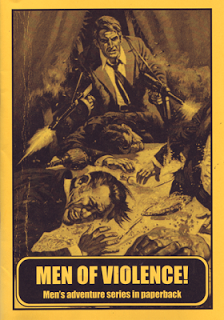 The least fulfilling aspects of zine publishing, for me, are the tasks not directly involved in writing and designing. Promotion, soliciting orders, storing back issues, stuffing and labelling hundreds of envelopes, queueing at the post office—all of these things are a total ball-ache. I try to avoid doing any of it. My system is to solicit pre-orders for a new publication stating a deadline for when I go to print. I then print almost the same numbers as pre-ordered, paying the printers to mail them out. This means I’m not out of pocket during the gap between paying the printers and receiving orders, nor am I sitting on boxes of back issues.
The least fulfilling aspects of zine publishing, for me, are the tasks not directly involved in writing and designing. Promotion, soliciting orders, storing back issues, stuffing and labelling hundreds of envelopes, queueing at the post office—all of these things are a total ball-ache. I try to avoid doing any of it. My system is to solicit pre-orders for a new publication stating a deadline for when I go to print. I then print almost the same numbers as pre-ordered, paying the printers to mail them out. This means I’m not out of pocket during the gap between paying the printers and receiving orders, nor am I sitting on boxes of back issues.
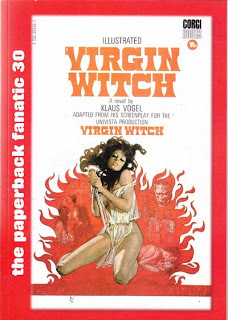 This approach does frustrate some people. If you don’t pre-order the zine, you stand little chance of tracking it down. When new readers come on board, they typically want to order back issues, and can be disappointed. Ultimately, however, it works for me. By eliminating those unnecessary distractions and tasks, it allows me to focus as much of my spare time as possible on writing and editing. People have suggested using print on demand through the likes of Amazon, but to date I have resisted. Primarily due to time restrictions in learning the technology, and also I’ve yet to see a color publication at an accessible price through Amazon. It could work for black and white, and I wonder if I was to produce a zine with a really niche appeal the only viable way to distribute could be print of demand.
This approach does frustrate some people. If you don’t pre-order the zine, you stand little chance of tracking it down. When new readers come on board, they typically want to order back issues, and can be disappointed. Ultimately, however, it works for me. By eliminating those unnecessary distractions and tasks, it allows me to focus as much of my spare time as possible on writing and editing. People have suggested using print on demand through the likes of Amazon, but to date I have resisted. Primarily due to time restrictions in learning the technology, and also I’ve yet to see a color publication at an accessible price through Amazon. It could work for black and white, and I wonder if I was to produce a zine with a really niche appeal the only viable way to distribute could be print of demand.
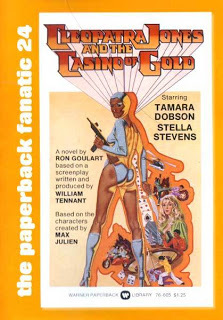 But I am committed to a print publication. I like the idea of a zine being a limited product, which asks something of the reader—if it is only to send an e-mail to be added to the distribution list, or making a pre-order PayPal payment. If I invest hours of my spare time in the producing the best zine I can, why shouldn’t I ask subscribers to make a little investment back? I don’t want a readership of passive consumers, and I’ll resist POD for as long as I can. What have been the rewards of publishing genre zines and the pitfalls you’ve faced to keep producing new issues?
But I am committed to a print publication. I like the idea of a zine being a limited product, which asks something of the reader—if it is only to send an e-mail to be added to the distribution list, or making a pre-order PayPal payment. If I invest hours of my spare time in the producing the best zine I can, why shouldn’t I ask subscribers to make a little investment back? I don’t want a readership of passive consumers, and I’ll resist POD for as long as I can. What have been the rewards of publishing genre zines and the pitfalls you’ve faced to keep producing new issues?
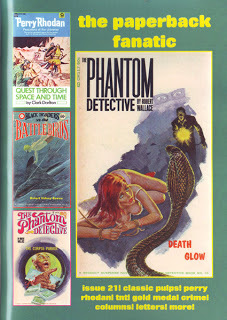 Self-publishing has been a hugely fulfilling hobby, bringing me into contact with a worldwide network of people sharing a common interest. You, for instance! It has also provided me with a creative outlet when my day-job doesn’t, which has genuinely been a boost to my mental well-being. I’m lucky to have a partner who understands zine publishing is an important part of my life, and supports it. She doesn’t get my obsession, but likes me having one. I have also been very proud to feature some excellent writers, and I have often been touched by the unconditional support provided by individuals in copy-editing, proofing, scanning and sharing knowledge.
Self-publishing has been a hugely fulfilling hobby, bringing me into contact with a worldwide network of people sharing a common interest. You, for instance! It has also provided me with a creative outlet when my day-job doesn’t, which has genuinely been a boost to my mental well-being. I’m lucky to have a partner who understands zine publishing is an important part of my life, and supports it. She doesn’t get my obsession, but likes me having one. I have also been very proud to feature some excellent writers, and I have often been touched by the unconditional support provided by individuals in copy-editing, proofing, scanning and sharing knowledge.
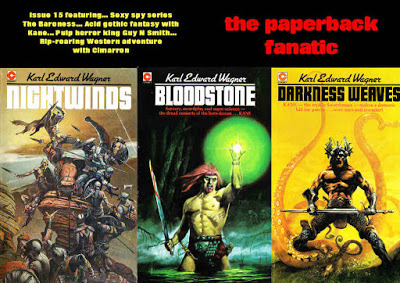 There have been some pit-falls, and some issues with individuals. However, I tend not to dwell on the negative. One of the most difficult things is keeping in touch with people, especially contributors. The reason I am able to produce zines on a fairly regular basis (approximately 50 paperback related pubs in the last 10 years) is I am disciplined with my time. Quite often I’ll have a window of only two hours in the evening between putting the girls to bed and calling it a night myself. Then I have to make a difficult call: Do I give X a Skype and shoot the breeze about cool paperbacks he scored, or, Do I finish the layouts for issue 36 of The Paperback Fanatic? It’s a difficult thing to explain to someone—you want to speak to me because you like my fanzine, but if I speak to you the next issue won’t get done. Why do you think it’s important to document the history of what many people mistakenly write off as disposable fiction? I’m not sure if it is important. I have a lot of contradictory views about the historical value of what appears in the pages of my zines. A lot of genre material from the ‘60s and ‘70s is utter crap. This is understandable, as it was intended to be disposable and the authors were often producing it under strict deadlines for next-to-no-money. But devoting so much of my energy and money to documenting these books does strike me as erecting temples to mediocrity.
There have been some pit-falls, and some issues with individuals. However, I tend not to dwell on the negative. One of the most difficult things is keeping in touch with people, especially contributors. The reason I am able to produce zines on a fairly regular basis (approximately 50 paperback related pubs in the last 10 years) is I am disciplined with my time. Quite often I’ll have a window of only two hours in the evening between putting the girls to bed and calling it a night myself. Then I have to make a difficult call: Do I give X a Skype and shoot the breeze about cool paperbacks he scored, or, Do I finish the layouts for issue 36 of The Paperback Fanatic? It’s a difficult thing to explain to someone—you want to speak to me because you like my fanzine, but if I speak to you the next issue won’t get done. Why do you think it’s important to document the history of what many people mistakenly write off as disposable fiction? I’m not sure if it is important. I have a lot of contradictory views about the historical value of what appears in the pages of my zines. A lot of genre material from the ‘60s and ‘70s is utter crap. This is understandable, as it was intended to be disposable and the authors were often producing it under strict deadlines for next-to-no-money. But devoting so much of my energy and money to documenting these books does strike me as erecting temples to mediocrity.
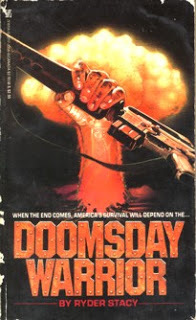 The British Library used to ask me for copies of The Paperback Fanatic for their archives, but I didn’t send them. I quite like the idea of the information in The Paperback Fanatic having an expiry date—crumbling with age as interest in print media disappears. I’m not sure of the value of preserving this information for future generations. I can’t see how knowing how many entries there were in the Doomsday Warrior series will enrich the world in 2050? I also have a hearty distrust of commentators who over-intellectualize popular culture. It’s as if they are trying to justify their interest in lowest common denominator material. Why not just admit you like it because it’s outrageous, shocking, violent, sexy, and unacceptable to the mainstream, or that you are a bit weird. Don’t try and dress it up in intellectual clothing.
The British Library used to ask me for copies of The Paperback Fanatic for their archives, but I didn’t send them. I quite like the idea of the information in The Paperback Fanatic having an expiry date—crumbling with age as interest in print media disappears. I’m not sure of the value of preserving this information for future generations. I can’t see how knowing how many entries there were in the Doomsday Warrior series will enrich the world in 2050? I also have a hearty distrust of commentators who over-intellectualize popular culture. It’s as if they are trying to justify their interest in lowest common denominator material. Why not just admit you like it because it’s outrageous, shocking, violent, sexy, and unacceptable to the mainstream, or that you are a bit weird. Don’t try and dress it up in intellectual clothing.
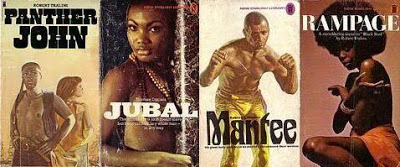 However, I do think looking back at vintage paperbacks can provide a real insight into wider society, often revealing some unpalatable truths—such as the huge popularity of the plantation genre in the ‘70s, which were bodice-rippersset against the background of the slave trade. They were full of racial stereotypes, sex, and sadism, so who the hell was buying these books in such large numbers? What was it about the national psyche they tapped into? What did/does it say about use as a supposedly civilized species? What do you think the popularity of genre fiction, especially in regards to Men of Violence, says about society in general? I would like to think it’s a healthy catharsis for most people—allowing escape from reality and providing some harmless wish-fulfilment. The repetition and formulaic nature of genre fiction is probably reassuring in a world of uncertainty. In the early ‘70s, it was Women’s Lib, Vietnam and Manson. In the 2010s, its terrorism and Trump. So, we may well be seeing a resurgence in escapist fiction, in the same way pulp magazine heroes such as Doc Savage became huge in the Depression.
However, I do think looking back at vintage paperbacks can provide a real insight into wider society, often revealing some unpalatable truths—such as the huge popularity of the plantation genre in the ‘70s, which were bodice-rippersset against the background of the slave trade. They were full of racial stereotypes, sex, and sadism, so who the hell was buying these books in such large numbers? What was it about the national psyche they tapped into? What did/does it say about use as a supposedly civilized species? What do you think the popularity of genre fiction, especially in regards to Men of Violence, says about society in general? I would like to think it’s a healthy catharsis for most people—allowing escape from reality and providing some harmless wish-fulfilment. The repetition and formulaic nature of genre fiction is probably reassuring in a world of uncertainty. In the early ‘70s, it was Women’s Lib, Vietnam and Manson. In the 2010s, its terrorism and Trump. So, we may well be seeing a resurgence in escapist fiction, in the same way pulp magazine heroes such as Doc Savage became huge in the Depression.
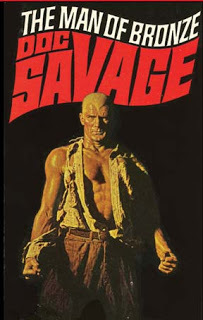 I think there are some people who enjoy the books because they reflect their personal politics. Fans of Jerry Ahern and William Johnston books particularly worry me. My personal politics are closer to socialist (although my dad tells me I am a champagne socialist). As a result, I struggle with the right-wing politics and the extreme sadism a few of the heroes display in some of the men’s adventure paperbacks. I also find the whole gun-porn aspect laughable. I don’t care anything about bullets and velocity, and am a bit scared of people who do. What are your favorite genre series? This may seem strange, but I get little pleasure from reading, or to be more specific, I get little pleasure in reading the books I choose. Often they are part of research for an article for the fanzines, rather than books I would choose to read.
I think there are some people who enjoy the books because they reflect their personal politics. Fans of Jerry Ahern and William Johnston books particularly worry me. My personal politics are closer to socialist (although my dad tells me I am a champagne socialist). As a result, I struggle with the right-wing politics and the extreme sadism a few of the heroes display in some of the men’s adventure paperbacks. I also find the whole gun-porn aspect laughable. I don’t care anything about bullets and velocity, and am a bit scared of people who do. What are your favorite genre series? This may seem strange, but I get little pleasure from reading, or to be more specific, I get little pleasure in reading the books I choose. Often they are part of research for an article for the fanzines, rather than books I would choose to read.
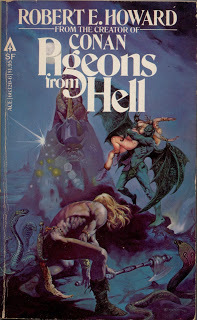 When I read, I tend not to be able to switch off and go with the flow. I’m always looking for common themes across an author’s work, examples of their prose to highlight or comment on, or trying to spot characteristics to decipher the true identity of the author hiding behind a pseudonym. My antidote is to have a small pile of authors and books I revisit from time to time, healing me whenever reading dreck gets too much for me. The pile includes Clark Ashton Smith, H P Lovecraft (my taste for Lovecraft has only recently been acquired), and some Robert E Howard—specifically Pigeons from Hell and Valley of the Worm. No doubt your readers will be familiar with those books and authors.
When I read, I tend not to be able to switch off and go with the flow. I’m always looking for common themes across an author’s work, examples of their prose to highlight or comment on, or trying to spot characteristics to decipher the true identity of the author hiding behind a pseudonym. My antidote is to have a small pile of authors and books I revisit from time to time, healing me whenever reading dreck gets too much for me. The pile includes Clark Ashton Smith, H P Lovecraft (my taste for Lovecraft has only recently been acquired), and some Robert E Howard—specifically Pigeons from Hell and Valley of the Worm. No doubt your readers will be familiar with those books and authors.
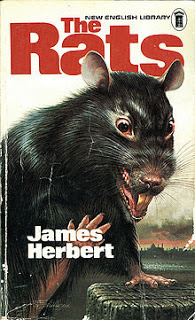 In terms of more slightly off-beat recommendations, there are Mick Norman’s Angels quartet, which have recently been e-booked by Piccadilly Publishing. Written in the ‘70s by a guy called Laurence James, who was a prolific western author and wrote the early Deathlands post-apocalypse books, they were hugely subversive and inventive stories of a biker gang called The Last Heroes. James Herbert’s earliest books, The Rats and The Fog have stood the test of time, ferocious and polemic, these are classics of horror fiction and not to be confused with their imitators.
In terms of more slightly off-beat recommendations, there are Mick Norman’s Angels quartet, which have recently been e-booked by Piccadilly Publishing. Written in the ‘70s by a guy called Laurence James, who was a prolific western author and wrote the early Deathlands post-apocalypse books, they were hugely subversive and inventive stories of a biker gang called The Last Heroes. James Herbert’s earliest books, The Rats and The Fog have stood the test of time, ferocious and polemic, these are classics of horror fiction and not to be confused with their imitators.
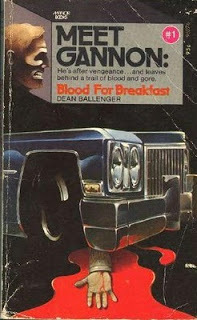 With regards to the men’s adventure genre, my favorites do tend to be the more off-beat and wild examples, so I’m not sure if they should be used as recommendations. An early favourite was the Gannon series, three books by Dean Ballenger published by Manor Books—about which rumors abounded. Documenting these was a motivator in publishing the first issue of Men of Violence, my fanzine dedicated to men’s adventure paperbacks. Well beyond the boundaries of good taste and written in ludicrous slang which I think Ballenger invented himself, you can let these books open at any page and be guaranteed to read a line so outrageous it will make you smile/shake your head.
With regards to the men’s adventure genre, my favorites do tend to be the more off-beat and wild examples, so I’m not sure if they should be used as recommendations. An early favourite was the Gannon series, three books by Dean Ballenger published by Manor Books—about which rumors abounded. Documenting these was a motivator in publishing the first issue of Men of Violence, my fanzine dedicated to men’s adventure paperbacks. Well beyond the boundaries of good taste and written in ludicrous slang which I think Ballenger invented himself, you can let these books open at any page and be guaranteed to read a line so outrageous it will make you smile/shake your head.
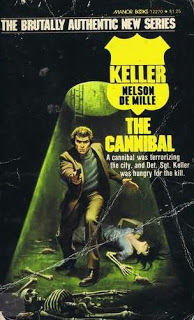 Also from Manor was the Rykertough-cop series, written by Nelson De Mille before he became a best-seller. With a totally obnoxious lead character sporting a sweat-stained suit and a hateful attitude, the books make excellent use of New York and its neighborhoods as a lead character. The Cannibal is a hard-boiled sleaze classic in the series, with a deranged veteran stalking the NY subways having developed a taste for human flesh whilst a POW in Vietnam. I also enjoy the French approach to men’s adventure, with the TNT and Malko series firm favorites, although they employ very different approaches. TNT is over the top and unbelievable, mixing sex and violence to such extremes it becomes surreal. Whilst Malkois known for the factual basis of the stories and the author’s extrapolation of current events.
Also from Manor was the Rykertough-cop series, written by Nelson De Mille before he became a best-seller. With a totally obnoxious lead character sporting a sweat-stained suit and a hateful attitude, the books make excellent use of New York and its neighborhoods as a lead character. The Cannibal is a hard-boiled sleaze classic in the series, with a deranged veteran stalking the NY subways having developed a taste for human flesh whilst a POW in Vietnam. I also enjoy the French approach to men’s adventure, with the TNT and Malko series firm favorites, although they employ very different approaches. TNT is over the top and unbelievable, mixing sex and violence to such extremes it becomes surreal. Whilst Malkois known for the factual basis of the stories and the author’s extrapolation of current events.
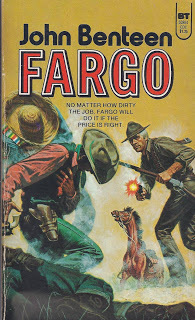 In terms of westerns, I always recommend two series to people who claim they do not like westerns—Fargo and Renegade—both of which could be regarded as closer to south-of-the-border soldier-of-fortune yarns, than traditional westerns. Great writing is great writing, irrespective of the genre trappings. While continuing to publish The Paperback Fanatic, Pulp Horror, and Men of Violence, what other specialty genres are you planning to cover? I have been mulling over a fanzine devoted to westerns, provisionally titled Hot Lead. My normal sounding boards have all told me it will be a disaster, and no-one will be interested, which only makes me want to do it all the more! Is there a grand plan behind all the hard work you do to document pulp and genre fiction, or is it simply personal satisfaction?
In terms of westerns, I always recommend two series to people who claim they do not like westerns—Fargo and Renegade—both of which could be regarded as closer to south-of-the-border soldier-of-fortune yarns, than traditional westerns. Great writing is great writing, irrespective of the genre trappings. While continuing to publish The Paperback Fanatic, Pulp Horror, and Men of Violence, what other specialty genres are you planning to cover? I have been mulling over a fanzine devoted to westerns, provisionally titled Hot Lead. My normal sounding boards have all told me it will be a disaster, and no-one will be interested, which only makes me want to do it all the more! Is there a grand plan behind all the hard work you do to document pulp and genre fiction, or is it simply personal satisfaction?
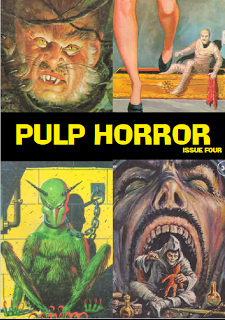 No grand plan. It’s purely satisfaction. Publishing fanzines is part of my DNA and I’ll continue to do it. I can’t imagine a time where I won’t be self-publishing. I don’t harbor any ambitions to be a published author or to make the zines a commercial product. Making the publications as accessible as possible in terms of prices is important to me, so I sell as close to cost as I can—taking into account the extortionate price of international postage. I think this helps the integrity of the zines, as I don’t need to compromise my views to please an advertiser or promote a project unless I believe in it. What would you like the legacy of The Paperback Fanaticto evolve into? I genuinely have not given it any thought until your question. I don’t know how to answer it really. I’m not even sure if I care about what The Paperback Fanatic’slegacy is at this stage. I genuinely don’t see my publications as a big deal, or worthy of a legacy.
No grand plan. It’s purely satisfaction. Publishing fanzines is part of my DNA and I’ll continue to do it. I can’t imagine a time where I won’t be self-publishing. I don’t harbor any ambitions to be a published author or to make the zines a commercial product. Making the publications as accessible as possible in terms of prices is important to me, so I sell as close to cost as I can—taking into account the extortionate price of international postage. I think this helps the integrity of the zines, as I don’t need to compromise my views to please an advertiser or promote a project unless I believe in it. What would you like the legacy of The Paperback Fanaticto evolve into? I genuinely have not given it any thought until your question. I don’t know how to answer it really. I’m not even sure if I care about what The Paperback Fanatic’slegacy is at this stage. I genuinely don’t see my publications as a big deal, or worthy of a legacy.
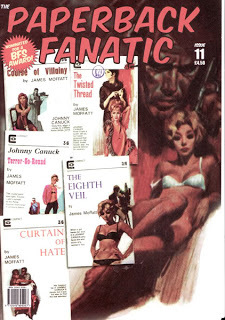 This stuff is written in a spare room in the evenings, with no experience in professional writing or design. It’s not art, it’s not difficult. I genuinely believe anyone can do it, with a little bit of ego and a lot of discipline. I think people would be surprised at how cheap it is to print a fanzine, and how desk-top-publishing programs make it relatively easy to produce something semi-professional. Stop watching funny cat videos on You Tube and do something positive with your time, like publishing a fanzine! ********
This stuff is written in a spare room in the evenings, with no experience in professional writing or design. It’s not art, it’s not difficult. I genuinely believe anyone can do it, with a little bit of ego and a lot of discipline. I think people would be surprised at how cheap it is to print a fanzine, and how desk-top-publishing programs make it relatively easy to produce something semi-professional. Stop watching funny cat videos on You Tube and do something positive with your time, like publishing a fanzine! ********
 Thanks Justin for answering my many intrusive questions in such a thoughtful and thorough manner. I feel this has been one of the most rewarding interviews I’ve done in a long time. I appreciate you...As do the many fans of your publications—long may they continue to run... For more info and to order available issues be sure to visit The Paperback Fanatic website: www.thepaperbackfanatic.com/
Thanks Justin for answering my many intrusive questions in such a thoughtful and thorough manner. I feel this has been one of the most rewarding interviews I’ve done in a long time. I appreciate you...As do the many fans of your publications—long may they continue to run... For more info and to order available issues be sure to visit The Paperback Fanatic website: www.thepaperbackfanatic.com/
Published on February 16, 2017 13:29
PAPERBACK FANATIC ALERT
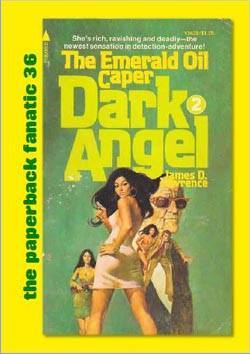 PAPERBACK FANATIC ALERT THREE NEW TOP GENRE ZINES AVAILABLE FOR PRE-ORDER On March 7th The Paperback Fanatic #36, Men of Violence #6, and Pulp Horror #5 will be going to print. Edited by the erudite genre czar Justin Marriott, these are must have zines for all aficionados of genre fiction…Copies are available for pre-order via The Paperback Fanatic website: www.thepaperbackfanatic.com/ These zines have a limited print run and sell out fast…The only way to ensure you receive a copy is to pre-order before March 7th...
PAPERBACK FANATIC ALERT THREE NEW TOP GENRE ZINES AVAILABLE FOR PRE-ORDER On March 7th The Paperback Fanatic #36, Men of Violence #6, and Pulp Horror #5 will be going to print. Edited by the erudite genre czar Justin Marriott, these are must have zines for all aficionados of genre fiction…Copies are available for pre-order via The Paperback Fanatic website: www.thepaperbackfanatic.com/ These zines have a limited print run and sell out fast…The only way to ensure you receive a copy is to pre-order before March 7th...
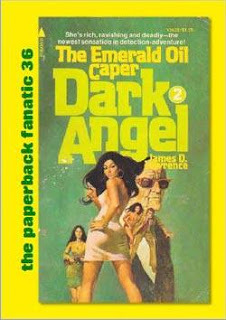 THE PAPERBACK FANATIC #36100 pages, all in color and with a book spine.Arizona, a book shopping Odyssey
THE PAPERBACK FANATIC #36100 pages, all in color and with a book spine.Arizona, a book shopping OdysseyMore comic book artists in paperback
Outlaw bikers in men's adventure mags
Lin Carter's Best Fantasy series
Collecting Lovecraft
The Dark Angel series
The Saint in Pan paperbacks
Gold Medal classic crime trial series
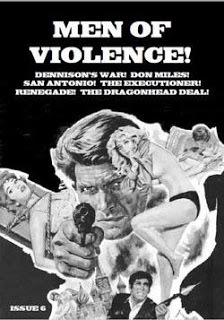 MEN OF VIOLENCE #640 pages, A5, black and white
MEN OF VIOLENCE #640 pages, A5, black and whiteMen's adventure paperbacks
The San Antonio series
Legal woes with The Executioner
Dennison's Army
Don Miles
Renegade
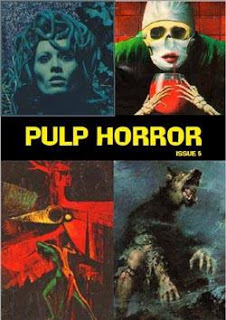 PULP HORROR 5100 pages, all in color, book spine.A Visual Guide to Frankenstein
PULP HORROR 5100 pages, all in color, book spine.A Visual Guide to FrankensteinOccult author Stewart Farrar
A History of the British Small Press
Neglected American writer Leslie Whitten PAPERBACK PARADE Limited stocks of US zine Paperback Parade issues 90-96 are also available for £10 each including postage and handling...
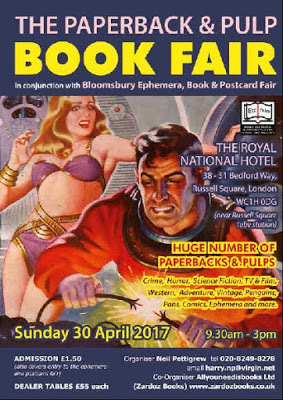 LONDON PAPERBACK FAIR WILL BE HELD OF APRIL 30TH, 2017 BE ON THE LOOKOUT FOR MY TERRIFIC EXCLUSIVE INTERVIEW WITH PAPERBACK FANATIC PUBLISHER JUSTIN MARRIOTT COMING SOON...
LONDON PAPERBACK FAIR WILL BE HELD OF APRIL 30TH, 2017 BE ON THE LOOKOUT FOR MY TERRIFIC EXCLUSIVE INTERVIEW WITH PAPERBACK FANATIC PUBLISHER JUSTIN MARRIOTT COMING SOON...
Published on February 16, 2017 09:38
February 9, 2017
THE OTHER MARLOWE
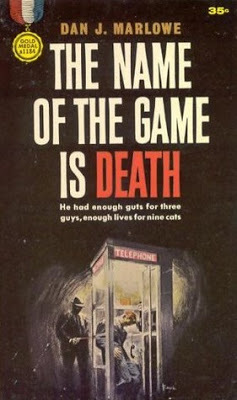
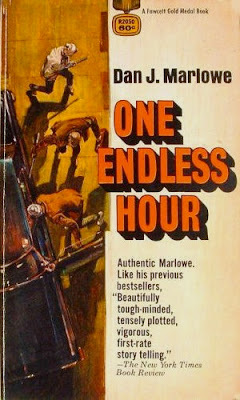 THE OTHER MARLOWE Published in the early sixties, Dan J. Marlowe’s novels The Name of the Game is Death and One Endless Hour are among the toughest examples of the hardboiled genre ever written. Both novels are blisteringly paced with noir-tinged muscular prose and featuring an amoral, unapologetic, criminal who wouldn’t know a sentiment if it attacked him with a baseball bat. They are perfect examples of why Fawcett’s Gold Medal paperback original imprint is so revered. "You don't deserve it, but I’ll give you a choice,” I said. “I was going to leave you out here, with the heat and the mosquitoes and the bugs and the snakes and the alligators. You’ll never make it in. I doubt if I could myself.” His whole face was wet as he stared at me. “You won’t go easy if you stay, so I’ll give you the choice. Stay, or take one dead center from this.” I waved the little handgun … “You’ll go out of your mind out here in twelve hours.” His chest was heaving as he tried to pump air through his constricted throat. “Take the bullet.” — From The Name of the Game is Death (1962)
THE OTHER MARLOWE Published in the early sixties, Dan J. Marlowe’s novels The Name of the Game is Death and One Endless Hour are among the toughest examples of the hardboiled genre ever written. Both novels are blisteringly paced with noir-tinged muscular prose and featuring an amoral, unapologetic, criminal who wouldn’t know a sentiment if it attacked him with a baseball bat. They are perfect examples of why Fawcett’s Gold Medal paperback original imprint is so revered. "You don't deserve it, but I’ll give you a choice,” I said. “I was going to leave you out here, with the heat and the mosquitoes and the bugs and the snakes and the alligators. You’ll never make it in. I doubt if I could myself.” His whole face was wet as he stared at me. “You won’t go easy if you stay, so I’ll give you the choice. Stay, or take one dead center from this.” I waved the little handgun … “You’ll go out of your mind out here in twelve hours.” His chest was heaving as he tried to pump air through his constricted throat. “Take the bullet.” — From The Name of the Game is Death (1962)
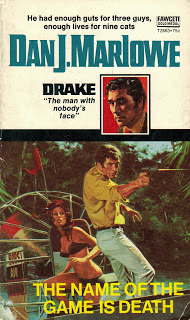 Marlowe’s anti-hero was originally named, Chet Arnold. The Gold Medal asked Marlowe to turn the standalone Name of the Game is Death into a series. In One Endless Hour, Marlowe responds by putting good ‘ol Chet under the plastic surgeon’s knife and morphing him into Earl Drake. This was not the only challenge of the transformation from standalone to series. There was also the ongoing challenge of making every villain more reprehensible than the renegade, sociopathic, felon who was the nominal hero of the violence filled tales. "Two guys with guts and a go-to-hell-with-you-Jack regard for consequences have about three chances in ten of pulling off a big, well-planned smash-and-grab. If one of them can shoot like me, the odds are a damn sight better."
Marlowe’s anti-hero was originally named, Chet Arnold. The Gold Medal asked Marlowe to turn the standalone Name of the Game is Death into a series. In One Endless Hour, Marlowe responds by putting good ‘ol Chet under the plastic surgeon’s knife and morphing him into Earl Drake. This was not the only challenge of the transformation from standalone to series. There was also the ongoing challenge of making every villain more reprehensible than the renegade, sociopathic, felon who was the nominal hero of the violence filled tales. "Two guys with guts and a go-to-hell-with-you-Jack regard for consequences have about three chances in ten of pulling off a big, well-planned smash-and-grab. If one of them can shoot like me, the odds are a damn sight better."
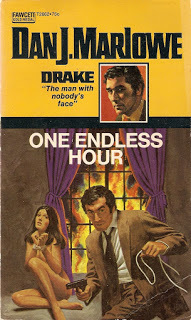 Despite being awkwardly labeled as the Man With Nobody's Face series, the books continued to be well written, retaining Marlowe’s callous, misanthropic narrative voice. However, this became an uphill battle as Gold Medal encouraged Marlowe to soften the Drake’s granite hardness by turning him into a Matt Helm secret agent clone to cash in on the Bond frenzy sweeping the nation. Despite this change, Marlowe’s signature theme of justice through revenge prevailed with the fourth book in the series, Flashpoint, winning an Edgar for Best Paperback Original. "I shot her in the throat, three times. ‘Tell your story in hell, if you can get anyone to listen,’ I told her. I stepped over her. I had work to do."
Despite being awkwardly labeled as the Man With Nobody's Face series, the books continued to be well written, retaining Marlowe’s callous, misanthropic narrative voice. However, this became an uphill battle as Gold Medal encouraged Marlowe to soften the Drake’s granite hardness by turning him into a Matt Helm secret agent clone to cash in on the Bond frenzy sweeping the nation. Despite this change, Marlowe’s signature theme of justice through revenge prevailed with the fourth book in the series, Flashpoint, winning an Edgar for Best Paperback Original. "I shot her in the throat, three times. ‘Tell your story in hell, if you can get anyone to listen,’ I told her. I stepped over her. I had work to do."
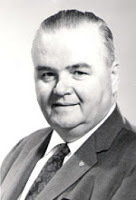 Marlowe had earned his chops writing two-fisted tough guy novels for Gold Medal and other paperback original publishers. But the Drake books brought him financial success, critical acclaim, and notoriety. The last sobriquet came from his long term friendship and mentoring of convicted bank robber and former member of the FBI's Most Wanted list, Albert F. Nussbaum.
Marlowe had earned his chops writing two-fisted tough guy novels for Gold Medal and other paperback original publishers. But the Drake books brought him financial success, critical acclaim, and notoriety. The last sobriquet came from his long term friendship and mentoring of convicted bank robber and former member of the FBI's Most Wanted list, Albert F. Nussbaum. Al “Bumpy” Nussbaum had gone on the lam after participating in a New York bank heist in which a guard had been killed. While attempting to lie low, the wanted felon read a copy of The Name of the Game is Death. The book resonated with Nussbaum, who had his own literary aspirations. Using a false name, Nussbaum called Marlowe asking for writing advise. It wasn’t until the FBI eventually arrested Nussbaum, that Marlowe learned who his fan boy caller really was.
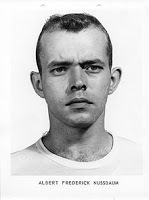 Intrigued, Marlowe began to correspond with the incarcerated Nussbaum. In return for writing advise, Nussbaum provided Marlowe with the inside dirt on how real criminals operate. This gave Marlowe’s further books an authenticity, which brought them almost to the level of Richard Stark’s series about the professional crook Parker. The story of Dan Marlowe, however, goes far deeper than his associating with an incarcerated criminal. In 1958, middle-aged and a grieving recent widow, Marlowe abandoned his business career and joined a novel writing workshop in New York. The lessons took and Avon snapped up Marlowe’s first five novels, all featuring the hardboiled Johnny Killain, a tough guy war vet working as a bellhop in New York who keeps getting dragged into a mix of danger and dames. During this time, Marlowe also published, Backfire, a standalone thriller.
Intrigued, Marlowe began to correspond with the incarcerated Nussbaum. In return for writing advise, Nussbaum provided Marlowe with the inside dirt on how real criminals operate. This gave Marlowe’s further books an authenticity, which brought them almost to the level of Richard Stark’s series about the professional crook Parker. The story of Dan Marlowe, however, goes far deeper than his associating with an incarcerated criminal. In 1958, middle-aged and a grieving recent widow, Marlowe abandoned his business career and joined a novel writing workshop in New York. The lessons took and Avon snapped up Marlowe’s first five novels, all featuring the hardboiled Johnny Killain, a tough guy war vet working as a bellhop in New York who keeps getting dragged into a mix of danger and dames. During this time, Marlowe also published, Backfire, a standalone thriller.
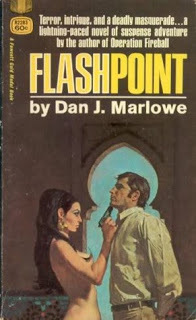 With these craft learning efforts out of the way, Marlowe dug down to write The Name of the Game is Death, which would remain his claim to fame and recognition despite an arm length list of further books. Still, the Drake books, all titles after One Endless Hour starting with the tag Operation (Flashpoint, Checkmate, Hammerlock, Death Maker, Stranglehold, etc.), became solid sellers along with a number of the other standalone novels Marlowe cranked out. The acclaim for these books brought Marlowe into the highest regard of The Mystery Writers of America fraternity and other social organizations. He became active in Republican politics. And, despite his less than manly appearance, he became an alcohol fueled womanizer. He was the toast of the New York mystery genre scene.
With these craft learning efforts out of the way, Marlowe dug down to write The Name of the Game is Death, which would remain his claim to fame and recognition despite an arm length list of further books. Still, the Drake books, all titles after One Endless Hour starting with the tag Operation (Flashpoint, Checkmate, Hammerlock, Death Maker, Stranglehold, etc.), became solid sellers along with a number of the other standalone novels Marlowe cranked out. The acclaim for these books brought Marlowe into the highest regard of The Mystery Writers of America fraternity and other social organizations. He became active in Republican politics. And, despite his less than manly appearance, he became an alcohol fueled womanizer. He was the toast of the New York mystery genre scene.
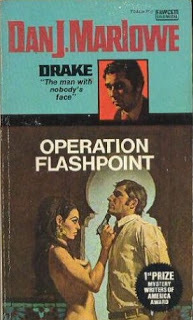 In 1978, as the market for the style of books he wrote evaporated, the sixty-four year old Marlowe moved to Hollywood to take on the movie business. Sharing an apartment with Nussbaum, the now paroled bank robber, Marlowe ran into the brick wall of Hollywood’s legendary disinterest in anyone or anything who wasn’t young, beautiful, and hip. He also began to be betrayed by his mind as loss of memory, glaucoma, and the ravages of a stroke made it hard to do anything, let alone type. Even his name worked against him, as Marlowe was often confused with Raymond Chandler’s iconic creation, or with the more successful writer Stephen Marlowe. Hollywood wanted nothing to do with the aging, infirmed, forgetful Dan Marlowe, and didn’t care a whit how popular his books once were. While Nussbaum was in prison, Marlowe had sold some of Nussbaum’s short stories under his own name, channeling the profits back to the incarcerated felon. Now, Nussbaum was beginning to have more publishing success than the fading Marlowe.
In 1978, as the market for the style of books he wrote evaporated, the sixty-four year old Marlowe moved to Hollywood to take on the movie business. Sharing an apartment with Nussbaum, the now paroled bank robber, Marlowe ran into the brick wall of Hollywood’s legendary disinterest in anyone or anything who wasn’t young, beautiful, and hip. He also began to be betrayed by his mind as loss of memory, glaucoma, and the ravages of a stroke made it hard to do anything, let alone type. Even his name worked against him, as Marlowe was often confused with Raymond Chandler’s iconic creation, or with the more successful writer Stephen Marlowe. Hollywood wanted nothing to do with the aging, infirmed, forgetful Dan Marlowe, and didn’t care a whit how popular his books once were. While Nussbaum was in prison, Marlowe had sold some of Nussbaum’s short stories under his own name, channeling the profits back to the incarcerated felon. Now, Nussbaum was beginning to have more publishing success than the fading Marlowe.
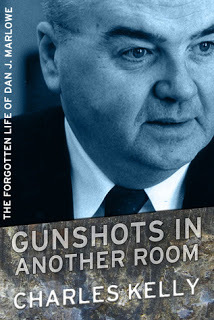 There were more issues. In Charles Kelly’s biography of Dan Marlowe, Gunshots In Another Room: The Forgotten Life Of Dan J. Marlowe, he revealed Marlowe’s publishing success was built on a lie. While Marlowe’s name was on the book covers, the words inside were mingled with those of Air Force Col. William C. Odell, an unassuming hero of WWII. According to Kelley, both names appeared only their 1967 novel, The Raven is a Blood-Red Bird, “...never again thereafter would Odell be credited on any of the dozen novels he worked on with Marlowe. Marlowe fronted all those books, using his more-marketable name. He even accepted an Edgar Allan Poe Award in 1971, for Operation Flashpoint, without publicly acknowledging Odell’s hefty contribution.” Kelley also exposed Marlowe’s strange sexual fetishes, including spanking, and the fact Marlowe wrote a number of pornographic novels under a pseudonym—despite his public condemnation of such pure filth. During the eight years Marlowe lived in Hollywood, often with or under the care of Nussbaum, his life deteriorated around him until his death in 1986. Plagued by amnesia, debilitating migraines, and the after effects of a stroke, his ability to write deserted him. As Kelley describes it; “[Marlowe] was trapped in a noir plot eerily similar to that of Never Live Twice, his 1964 thriller in which amnesia blanks out the mind of government operative Jackrabbit Smith, who has to fight his way back to his old life, blasting bad guys and spanking a woman psychologist along the way.” The further decent of Marlowe’s tragic latter days is covered meticulously in the pages of Charles Kelley’s fascinating in-depth biography. It is well reading, especially for hardboiled aficionados of the Gold Medal writers, of which Marlowe was a stellar representative. Despite Marlowe’s complex ethical and sexual behaviors, there is no denying the brilliance of The Name of the Game is Death and One Endless Hour. Both books will remain the standard against which all other hardboiled fiction must be judged. THE EARL DRAKE NOVELS •The Name of the Game is Death (1962) •One Endless Hour (1968) •Operation Fireball (1969) •Flashpoint (1970) •Operation Breakthrough (1971) •Operation Drumfire (1972) •Operation Checkmate (1972) •Operation Stranglehold (1973) •Operation Whiplash (1973) •Operation Hammerlock (1974) •Operation Deathmaker (1975) •Operation Counterpunch (1976)
There were more issues. In Charles Kelly’s biography of Dan Marlowe, Gunshots In Another Room: The Forgotten Life Of Dan J. Marlowe, he revealed Marlowe’s publishing success was built on a lie. While Marlowe’s name was on the book covers, the words inside were mingled with those of Air Force Col. William C. Odell, an unassuming hero of WWII. According to Kelley, both names appeared only their 1967 novel, The Raven is a Blood-Red Bird, “...never again thereafter would Odell be credited on any of the dozen novels he worked on with Marlowe. Marlowe fronted all those books, using his more-marketable name. He even accepted an Edgar Allan Poe Award in 1971, for Operation Flashpoint, without publicly acknowledging Odell’s hefty contribution.” Kelley also exposed Marlowe’s strange sexual fetishes, including spanking, and the fact Marlowe wrote a number of pornographic novels under a pseudonym—despite his public condemnation of such pure filth. During the eight years Marlowe lived in Hollywood, often with or under the care of Nussbaum, his life deteriorated around him until his death in 1986. Plagued by amnesia, debilitating migraines, and the after effects of a stroke, his ability to write deserted him. As Kelley describes it; “[Marlowe] was trapped in a noir plot eerily similar to that of Never Live Twice, his 1964 thriller in which amnesia blanks out the mind of government operative Jackrabbit Smith, who has to fight his way back to his old life, blasting bad guys and spanking a woman psychologist along the way.” The further decent of Marlowe’s tragic latter days is covered meticulously in the pages of Charles Kelley’s fascinating in-depth biography. It is well reading, especially for hardboiled aficionados of the Gold Medal writers, of which Marlowe was a stellar representative. Despite Marlowe’s complex ethical and sexual behaviors, there is no denying the brilliance of The Name of the Game is Death and One Endless Hour. Both books will remain the standard against which all other hardboiled fiction must be judged. THE EARL DRAKE NOVELS •The Name of the Game is Death (1962) •One Endless Hour (1968) •Operation Fireball (1969) •Flashpoint (1970) •Operation Breakthrough (1971) •Operation Drumfire (1972) •Operation Checkmate (1972) •Operation Stranglehold (1973) •Operation Whiplash (1973) •Operation Hammerlock (1974) •Operation Deathmaker (1975) •Operation Counterpunch (1976)
Published on February 09, 2017 13:01
WRITING MYTHS—BOOK SIGNINGS
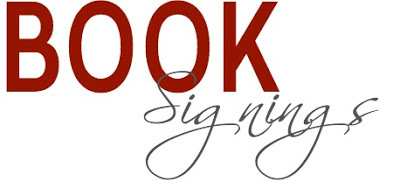 ~ WRITING MYTHS—BOOK SIGNINGS ~ Fair Warning: What follows is from personal experience...Mileage may vary for other writers... I recently participated in The First Annual Local Authors Book Fair sponsored by my community library. The library’s community room was spacious and as beautifully designed as the rest of the large library itself. My table was set, my hair slicked back, and my friendly smile in place. There were forty other authors at the event, each at their own table, each with their own smile and their own books to sell. Unfortunately, to say the browser to author ratio throughout the day was two to one is generous. Cash buyers? What are those?
~ WRITING MYTHS—BOOK SIGNINGS ~ Fair Warning: What follows is from personal experience...Mileage may vary for other writers... I recently participated in The First Annual Local Authors Book Fair sponsored by my community library. The library’s community room was spacious and as beautifully designed as the rest of the large library itself. My table was set, my hair slicked back, and my friendly smile in place. There were forty other authors at the event, each at their own table, each with their own smile and their own books to sell. Unfortunately, to say the browser to author ratio throughout the day was two to one is generous. Cash buyers? What are those?
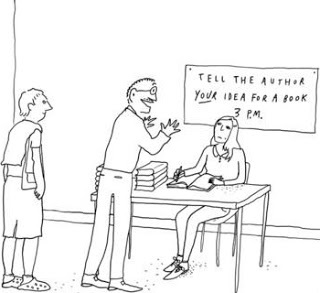 The fair was held on a Sunday from mid-morning to two o’clock in the afternoon. Three hours of silently screaming inside my mind, please buy my book...please like me...All the time smiling and vocally responding, The bathroom is over there...The free coffee and pastries are in the side room...Yes, I did write all the words in this book myself...No, they haven’t made a movie from any of my books…I don’t know why not...I’m glad you have an idea for a bestselling book…No, I won’t write it for you and split the profits…I’m sorry, I can’t edit your 500,000 word fantasy epic for free...I’m sorry, I can’t read the first ten chapters of your book and tell you what I think for free...I’m sorry you feel that way about my refusal to help beginning writers...Perhaps you should not use that language in such a loud voice as there are a lot of children around...If it were anatomically possible, I would be happy to do as you suggest...Meanwhile, I did not sell a single book during the hours of quiet desperation shared with every author there. Why do we put ourselves through this frustrating and ultimately humiliating experience? Because shilling books is considered required behavior for the huge percentage of authors who are not James Patterson, an anointed twentysomething wunderkind writing Y/A fantasy, or any of the big name authors who appear regularly on USA Today’s Bestsellers list. It is the bane of our existence. The weight on our shoulders.
The fair was held on a Sunday from mid-morning to two o’clock in the afternoon. Three hours of silently screaming inside my mind, please buy my book...please like me...All the time smiling and vocally responding, The bathroom is over there...The free coffee and pastries are in the side room...Yes, I did write all the words in this book myself...No, they haven’t made a movie from any of my books…I don’t know why not...I’m glad you have an idea for a bestselling book…No, I won’t write it for you and split the profits…I’m sorry, I can’t edit your 500,000 word fantasy epic for free...I’m sorry, I can’t read the first ten chapters of your book and tell you what I think for free...I’m sorry you feel that way about my refusal to help beginning writers...Perhaps you should not use that language in such a loud voice as there are a lot of children around...If it were anatomically possible, I would be happy to do as you suggest...Meanwhile, I did not sell a single book during the hours of quiet desperation shared with every author there. Why do we put ourselves through this frustrating and ultimately humiliating experience? Because shilling books is considered required behavior for the huge percentage of authors who are not James Patterson, an anointed twentysomething wunderkind writing Y/A fantasy, or any of the big name authors who appear regularly on USA Today’s Bestsellers list. It is the bane of our existence. The weight on our shoulders.
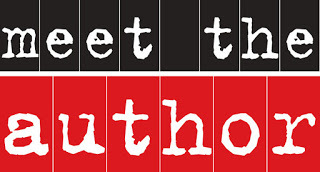 We would kill for a book signing line as long as those (deservedly) for Michael Connelly. Nirvana would be a book signing line as long as those (deservedly) for Sue Grafton. We’d even settle for the book signing lines for those (undeservedly) celebrities signing ghostwritten salacious tell-alls about their wonderful lives of overcoming sexual addiction, drug addiction, and several other addictions, while remaining a focus of adulation. The reality for most authors, however, is being lucky enough to have a book signing line longer than the queue for the women’s restroom during half-time at a high school football game. We continue to put ourselves through this experience hoping against hope for things to change. We do it because we are told if we don’t promote our own work nobody else will. We do it because we think it will make a difference. We are wrong.
We would kill for a book signing line as long as those (deservedly) for Michael Connelly. Nirvana would be a book signing line as long as those (deservedly) for Sue Grafton. We’d even settle for the book signing lines for those (undeservedly) celebrities signing ghostwritten salacious tell-alls about their wonderful lives of overcoming sexual addiction, drug addiction, and several other addictions, while remaining a focus of adulation. The reality for most authors, however, is being lucky enough to have a book signing line longer than the queue for the women’s restroom during half-time at a high school football game. We continue to put ourselves through this experience hoping against hope for things to change. We do it because we are told if we don’t promote our own work nobody else will. We do it because we think it will make a difference. We are wrong.
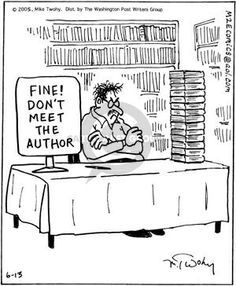 Book signings are a vanity effort in futility. They are the cliché we writers have all come to accept as a symbol of success—an indication we have arrived; our efforts sweating over sentences and paragraphs have been worthwhile; a medal awarded for surviving the wordslinger wars. Doctors wince when they watch medical shows on television. Lawyers cringe at the legal antics of modern Perry Masons. As an experienced police detective, I pull my hair out watching TV cop shows. My wife won’t even let me watch real cop shows, such as The First 48, because I end up yelling at the television about every missed clue and flubbed interrogation. Yet somehow, we writers expect book signings to be exactly like those dream fulfilling literary soirées in movies and television. Why? Because, we want the dream to be real. Even after reality slaps us across the chops, we somehow keep coming back for more thinking it will be different the next time. I’ve heard that referred to as the definition of insanity—which many of us writers suffer at least on a small scale. You don’t think so? How many health people stay in their house all day, in their pajamas, playing with imaginary friends? It’s an old saying but no less true… In my experience, the number of books sold at even a moderately successful solo book signing will never make a blip on a royalty statement—and after vanity satisfaction, book signings are supposed to be all about selling and promoting books. I don’t like it...I won’t go...and I’m not going to do it anymore... Is there a recourse to this charade? I believe there are two similar, but far more worthwhile promotional activities related to book signings. The first is participating in book signings with a group of two or three other authors. In the best case scenario these would be authors with whom you are friends. But even if you don’t know each other, the peer support is central to the activity.
Book signings are a vanity effort in futility. They are the cliché we writers have all come to accept as a symbol of success—an indication we have arrived; our efforts sweating over sentences and paragraphs have been worthwhile; a medal awarded for surviving the wordslinger wars. Doctors wince when they watch medical shows on television. Lawyers cringe at the legal antics of modern Perry Masons. As an experienced police detective, I pull my hair out watching TV cop shows. My wife won’t even let me watch real cop shows, such as The First 48, because I end up yelling at the television about every missed clue and flubbed interrogation. Yet somehow, we writers expect book signings to be exactly like those dream fulfilling literary soirées in movies and television. Why? Because, we want the dream to be real. Even after reality slaps us across the chops, we somehow keep coming back for more thinking it will be different the next time. I’ve heard that referred to as the definition of insanity—which many of us writers suffer at least on a small scale. You don’t think so? How many health people stay in their house all day, in their pajamas, playing with imaginary friends? It’s an old saying but no less true… In my experience, the number of books sold at even a moderately successful solo book signing will never make a blip on a royalty statement—and after vanity satisfaction, book signings are supposed to be all about selling and promoting books. I don’t like it...I won’t go...and I’m not going to do it anymore... Is there a recourse to this charade? I believe there are two similar, but far more worthwhile promotional activities related to book signings. The first is participating in book signings with a group of two or three other authors. In the best case scenario these would be authors with whom you are friends. But even if you don’t know each other, the peer support is central to the activity. 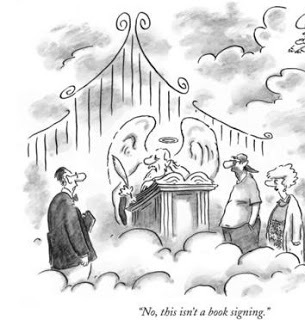 You have to have a different mindset to make this type of event enjoyable. Instead of focusing on book sales, your focus should be to simply enjoy spending an afternoon hanging out with friends or meeting new writers. This type of friendly interaction, or perhaps low key networking, makes the time fly. If you sell a couple of books great. If you don’t, you’ve enjoyed spending time with friends and colleagues—sharing the mutual joys and pains of writing—which should be the point of the activity. I’ll participate in these when invited and always find it a good time to catch up and interact with my real friends instead of my imaginary ones. The other activity I enjoy with ties to book signings is the opportunity to talk to service groups in the community, writers organizations, and other worthy concerns. If you have a fear of public speaking this might not be in your skill set, but a couple of Toastmasters meetings and you should be able to get beyond your phobias. I now have half a dozen topics I can talk on to suit most of the speaking opportunities I am offered. Now don’t go shrugging your shoulders thinking I’m a party animal extrovert. In my view, the definition of an extrovert gets recharged being around people. An introvert needs alone or quite time to recharge. An extrovert goes to a party tonight and is all fired up to go to another tomorrow and another the next day. An introvert goes to a party tonight and, no matter how much they enjoyed themselves, needs some solitude before they can venture out to socialize again. By this definition, I am firmly in the introvert camp, but it doesn’t mean I can be outgoing when needed.
You have to have a different mindset to make this type of event enjoyable. Instead of focusing on book sales, your focus should be to simply enjoy spending an afternoon hanging out with friends or meeting new writers. This type of friendly interaction, or perhaps low key networking, makes the time fly. If you sell a couple of books great. If you don’t, you’ve enjoyed spending time with friends and colleagues—sharing the mutual joys and pains of writing—which should be the point of the activity. I’ll participate in these when invited and always find it a good time to catch up and interact with my real friends instead of my imaginary ones. The other activity I enjoy with ties to book signings is the opportunity to talk to service groups in the community, writers organizations, and other worthy concerns. If you have a fear of public speaking this might not be in your skill set, but a couple of Toastmasters meetings and you should be able to get beyond your phobias. I now have half a dozen topics I can talk on to suit most of the speaking opportunities I am offered. Now don’t go shrugging your shoulders thinking I’m a party animal extrovert. In my view, the definition of an extrovert gets recharged being around people. An introvert needs alone or quite time to recharge. An extrovert goes to a party tonight and is all fired up to go to another tomorrow and another the next day. An introvert goes to a party tonight and, no matter how much they enjoyed themselves, needs some solitude before they can venture out to socialize again. By this definition, I am firmly in the introvert camp, but it doesn’t mean I can be outgoing when needed.
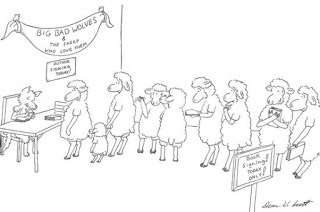 In the first few months of this year, I’ve spoken to several law enforcement groups, the American Association of University Women, the county Assistance League, and a large writers’ group. After I’ve given a twenty to forty-five minute presentation, many of the attendees buy books, which I make available at all venues. The key again is not book sales. It’s genuine social interaction and perpetuating good word of mouth. Each time I speak, it leads to further opportunities to speak at other venue— creating more good will. An example is my recent experience speaking to the American Association of University Women. After my talk, I was approached by a member about becoming a lecturer at the local California State University. This pleasant encounter led directly to being paid to teach three different courses for seniors (over 50) at the university. Who knows what possibilities I’ll talk my way into next. Book signings where I sit at a table by myself in the middle of a store waiting desperately to sell books is a thing of the past for me. The Hollywood dream of book signing literary soirées hasn’t so much been crushed as revealed to be a hollow fallacy. I’d much rather have fun with fellow authors or friendly community members, sell books or don’t sell books, and call it a successful event...
In the first few months of this year, I’ve spoken to several law enforcement groups, the American Association of University Women, the county Assistance League, and a large writers’ group. After I’ve given a twenty to forty-five minute presentation, many of the attendees buy books, which I make available at all venues. The key again is not book sales. It’s genuine social interaction and perpetuating good word of mouth. Each time I speak, it leads to further opportunities to speak at other venue— creating more good will. An example is my recent experience speaking to the American Association of University Women. After my talk, I was approached by a member about becoming a lecturer at the local California State University. This pleasant encounter led directly to being paid to teach three different courses for seniors (over 50) at the university. Who knows what possibilities I’ll talk my way into next. Book signings where I sit at a table by myself in the middle of a store waiting desperately to sell books is a thing of the past for me. The Hollywood dream of book signing literary soirées hasn’t so much been crushed as revealed to be a hollow fallacy. I’d much rather have fun with fellow authors or friendly community members, sell books or don’t sell books, and call it a successful event...
Published on February 09, 2017 09:32
February 7, 2017
WORD WATCHERS ~ CUT THE FAT NOW
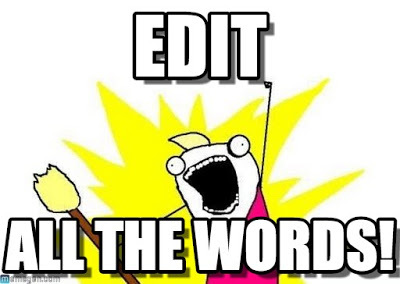 WORD WATCHERS ~ CUT THE FAT NOW The experience of editing over fifty books and repeatedly slashing red ink across the same words and phrases, has made me hyper aware of the same issues in my own writing. I now mercilessly try to eliminate all of the same fat in my manuscripts I’ve scalpeled from others. To write leaner more impactful prose, you must not only be willing to eliminate flabby sentences and fat words, you need to be able to recognize them. To help with this process there should be a self-help program for writers to join—Word Watchers: Lose 10% Of Your Manuscript In 10 Days... Members of the writers’ group I mentor know I am on a quest to eliminate the word that from the English language. As an editor, I’ve found the dreaded word to be riddled unnecessarily through almost every manuscript I review. My rule is, if you can remove that from a sentence and the sentence still makes sense, run the word out of town on a log. Compare the following: •She needed to tell him that the car wouldn’t start. •She needed to tell him the car wouldn’t start. •I was glad that she was doing better. •I was glad she was doing better. In both examples, the sentence becomes stronger by removing the weak link of the word, that. Use a word search to see how many times that appears in your manuscript. You’ll be shocked. It’s especially overwhelming when you realize 95% of thatscould be excised. Removing this scourge will strengthen your sentences without changing the integrity of your prose. Of is another overused word I can guarantee is cluttering up your manuscript like a bad case of acne. Compare the following: •He examined the damaged paw of the dog •He examined the dog’s injured paw. You decide which sentence is stronger, leaner, expressed more concisely. Now think about how many sentences in your manuscript are being blemished by the of virus.
WORD WATCHERS ~ CUT THE FAT NOW The experience of editing over fifty books and repeatedly slashing red ink across the same words and phrases, has made me hyper aware of the same issues in my own writing. I now mercilessly try to eliminate all of the same fat in my manuscripts I’ve scalpeled from others. To write leaner more impactful prose, you must not only be willing to eliminate flabby sentences and fat words, you need to be able to recognize them. To help with this process there should be a self-help program for writers to join—Word Watchers: Lose 10% Of Your Manuscript In 10 Days... Members of the writers’ group I mentor know I am on a quest to eliminate the word that from the English language. As an editor, I’ve found the dreaded word to be riddled unnecessarily through almost every manuscript I review. My rule is, if you can remove that from a sentence and the sentence still makes sense, run the word out of town on a log. Compare the following: •She needed to tell him that the car wouldn’t start. •She needed to tell him the car wouldn’t start. •I was glad that she was doing better. •I was glad she was doing better. In both examples, the sentence becomes stronger by removing the weak link of the word, that. Use a word search to see how many times that appears in your manuscript. You’ll be shocked. It’s especially overwhelming when you realize 95% of thatscould be excised. Removing this scourge will strengthen your sentences without changing the integrity of your prose. Of is another overused word I can guarantee is cluttering up your manuscript like a bad case of acne. Compare the following: •He examined the damaged paw of the dog •He examined the dog’s injured paw. You decide which sentence is stronger, leaner, expressed more concisely. Now think about how many sentences in your manuscript are being blemished by the of virus.
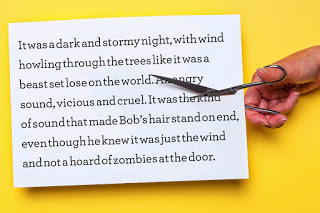 FAT WORDS That and of are hardly the only fat words making unwelcome guest appearances in your prose. A strategic search and destroy mission needs to be implemented to eliminate other insidious manuscript invaders.So That Just Very Like Still Somehow Eventually Suddenly Finally A little The fact Once Beginning Both Any Seemed Began Almost FAT CLICHÉS Even when you’ve ruthlessly cut all the fat words from your manuscript, you’re still not done. Your writing will be stronger and more vibrant if you create fresh ways to replace lazy cliché phrases. I was once admonished by a script editor for the many clichés I habitually used—often repeatedly. I was duly embarrassed by all the red ink highlighting the clichés in my script. These were not only cliché phrases—avoid like the plague, you can’t please everyone, the grass is always greener, what doesn’t kill you makes you stronger, don’t judge a book by its cover, Firing on all cylinders—but other less obvious clichés: The point being At this point If the time ever came As if she were As a result Well and good Light of day Both of which Put an end*For an exhaustive list of clichés
click here
FAT WORDS That and of are hardly the only fat words making unwelcome guest appearances in your prose. A strategic search and destroy mission needs to be implemented to eliminate other insidious manuscript invaders.So That Just Very Like Still Somehow Eventually Suddenly Finally A little The fact Once Beginning Both Any Seemed Began Almost FAT CLICHÉS Even when you’ve ruthlessly cut all the fat words from your manuscript, you’re still not done. Your writing will be stronger and more vibrant if you create fresh ways to replace lazy cliché phrases. I was once admonished by a script editor for the many clichés I habitually used—often repeatedly. I was duly embarrassed by all the red ink highlighting the clichés in my script. These were not only cliché phrases—avoid like the plague, you can’t please everyone, the grass is always greener, what doesn’t kill you makes you stronger, don’t judge a book by its cover, Firing on all cylinders—but other less obvious clichés: The point being At this point If the time ever came As if she were As a result Well and good Light of day Both of which Put an end*For an exhaustive list of clichés
click here
 CHOOSE LEAN WORDS TO REPLACE THE FAT Fat words strung together can bulk out your sentences with empty calories. Make healthier word choices to make your prose more efficient… REPLACE: • the reason for • for the reason that • due to the fact that • owing to the fact that • in light of the fact that • considering the fact that • on the grounds that • this is whyWITH: BECAUSE, SINCE, WHY REPLACE: • despite the fact that • regardless of the fact that • notwithstanding the fact that WITH: ALTHOUGH, EVEN, THOUGH REPLACE: • in the event that • if it should transpire/happen that • under circumstances in whichWITH: IF REPLACE: • on the occasion of • in a situation in which • under circumstances in whichWITH: WHEN REPLACE: • as regards • in reference to • with regard to • concerning the matter of • where...is concerned WITH: ABOUT REPLACE: • it is crucial that • it is necessary that • there is a need/necessity for • it is important that • it is incumbent upon • cannot be avoided WITH: MUST, SHOULD REPLACE: • is able to • has the opportunity to • is in a position to • has the capacity for • has the ability to WITH: CAN REPLACE: • it is possible that • there is a chance that • it could happen that • the possibility exists for WITH:
MAY, MIGHT, CAN, COULD
REPLACE: • prior to • in anticipation of • subsequent to • following on • at the same time as • simultaneously withWITH: BEFORE, AFTER, AS
CHOOSE LEAN WORDS TO REPLACE THE FAT Fat words strung together can bulk out your sentences with empty calories. Make healthier word choices to make your prose more efficient… REPLACE: • the reason for • for the reason that • due to the fact that • owing to the fact that • in light of the fact that • considering the fact that • on the grounds that • this is whyWITH: BECAUSE, SINCE, WHY REPLACE: • despite the fact that • regardless of the fact that • notwithstanding the fact that WITH: ALTHOUGH, EVEN, THOUGH REPLACE: • in the event that • if it should transpire/happen that • under circumstances in whichWITH: IF REPLACE: • on the occasion of • in a situation in which • under circumstances in whichWITH: WHEN REPLACE: • as regards • in reference to • with regard to • concerning the matter of • where...is concerned WITH: ABOUT REPLACE: • it is crucial that • it is necessary that • there is a need/necessity for • it is important that • it is incumbent upon • cannot be avoided WITH: MUST, SHOULD REPLACE: • is able to • has the opportunity to • is in a position to • has the capacity for • has the ability to WITH: CAN REPLACE: • it is possible that • there is a chance that • it could happen that • the possibility exists for WITH:
MAY, MIGHT, CAN, COULD
REPLACE: • prior to • in anticipation of • subsequent to • following on • at the same time as • simultaneously withWITH: BEFORE, AFTER, AS
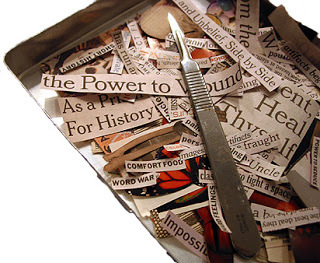 TRIMMING FAT SENTENCES Here are some examples from my Fey Croaker novels of sentences filled with empty calorie words and how they should have been written... FAT: …a self-loathing that often cracked her self-esteem as if it were a piece of fine crystal threatened by a diva's high notes. TIGHTER: …a self-esteem as fragile as fine crystal threatened by a diva's high notes. FAT: She considered, ever so briefly, the fact that her service revolver was in her purse. TIGHTER: She briefly considered the service revolver in her purse. FAT: Fey was about to enter the playing field of the interrogation room. TIGHTER: Fey entered the playing field of the interrogation room. FAT: Thieftaker nickered as soon as he saw Fey and trotted over to the corral fence to meet her. His greeting alerted Constable, who also made his way over to the steel-pole fence. Peter Dent's three horses were also in the corral, but they ignored the activity as if it weren't occurring. Peter's rear yard was larger than Fey's, and with inherited money he had been able to build far more extensive facilities for his horses than what Fey had created. For Fey's part, though, she did not envy Peter all the extra work that the fancy setup required. She had more than her hands full with her own place and working full-time. She was grateful, however, that Peter was available to help out with her animals when she needed, and also that he had no problems letting Thieftaker and Constable reside in his yard. Fey fondled her horses' muzzles and whispered to them in a soothing voice. TIGHTER: Peter Dent had more acreage and used inherited money to build larger stables. They were beautiful, but labor intensive. Fey was grateful for Peter’s help, but didn’t envy him the extra work. Thieftaker nickered when he saw Fey. The horse trotted over to the steep-poled corral fence to meet her with Constable following. Fey fondled her horses' muzzles, whispering in a soothing voice. FAT: Fey knew she should feel tired. After all, she'd been up for over twenty-four hours, but she couldn't remember a time when she had felt more awake or more alive. All of the instincts and experience honed to a fine edge by her years as a detective were firing on all cylinders. This is what it must feel like, Fey thought, when a top athlete knows she is going to win a championship even before her event starts. There is a power that comes from somewhere within, a positive knowledge that at a given moment, in a given place, there is nobody who can stand in the way of your success. TIGHTER: Fey knew she should feel tired. She'd been awake over twenty-four hours, but she couldn't remember a time when she had felt more alive. The instincts and experience honed to a fine edge by her years as a detective were firing with energy. Fey wondered if great athletes felt this same overwhelming sense of euphoria before the start of a championship game The power coming from within—the positive knowledge at this moment, in this place, you can’t be stopped. FAT: Fey was about to enter the playing field of the interrogation room. It was the final play of the game. There were ten seconds left on the clock, and it was fourth down and forever to go. Fey was about to throw up the Hail Mary pass, but there was no doubt in any fiber of her body that the ball would be caught for the winning touchdown. TIGHTER: Fey entered the playing field of the interrogation room—final play of the game; ten seconds left on the clock; fourth down and forever to go. There was no backing down. Examine your own writing. Is it filled with flabby word count sentences? Can it be tightened and streamlined by better word choices? Has relying on clichés made your writing lazy? If so, it’s time to weigh in at your local Word Watchers chapter and start losing the ugly fat.
TRIMMING FAT SENTENCES Here are some examples from my Fey Croaker novels of sentences filled with empty calorie words and how they should have been written... FAT: …a self-loathing that often cracked her self-esteem as if it were a piece of fine crystal threatened by a diva's high notes. TIGHTER: …a self-esteem as fragile as fine crystal threatened by a diva's high notes. FAT: She considered, ever so briefly, the fact that her service revolver was in her purse. TIGHTER: She briefly considered the service revolver in her purse. FAT: Fey was about to enter the playing field of the interrogation room. TIGHTER: Fey entered the playing field of the interrogation room. FAT: Thieftaker nickered as soon as he saw Fey and trotted over to the corral fence to meet her. His greeting alerted Constable, who also made his way over to the steel-pole fence. Peter Dent's three horses were also in the corral, but they ignored the activity as if it weren't occurring. Peter's rear yard was larger than Fey's, and with inherited money he had been able to build far more extensive facilities for his horses than what Fey had created. For Fey's part, though, she did not envy Peter all the extra work that the fancy setup required. She had more than her hands full with her own place and working full-time. She was grateful, however, that Peter was available to help out with her animals when she needed, and also that he had no problems letting Thieftaker and Constable reside in his yard. Fey fondled her horses' muzzles and whispered to them in a soothing voice. TIGHTER: Peter Dent had more acreage and used inherited money to build larger stables. They were beautiful, but labor intensive. Fey was grateful for Peter’s help, but didn’t envy him the extra work. Thieftaker nickered when he saw Fey. The horse trotted over to the steep-poled corral fence to meet her with Constable following. Fey fondled her horses' muzzles, whispering in a soothing voice. FAT: Fey knew she should feel tired. After all, she'd been up for over twenty-four hours, but she couldn't remember a time when she had felt more awake or more alive. All of the instincts and experience honed to a fine edge by her years as a detective were firing on all cylinders. This is what it must feel like, Fey thought, when a top athlete knows she is going to win a championship even before her event starts. There is a power that comes from somewhere within, a positive knowledge that at a given moment, in a given place, there is nobody who can stand in the way of your success. TIGHTER: Fey knew she should feel tired. She'd been awake over twenty-four hours, but she couldn't remember a time when she had felt more alive. The instincts and experience honed to a fine edge by her years as a detective were firing with energy. Fey wondered if great athletes felt this same overwhelming sense of euphoria before the start of a championship game The power coming from within—the positive knowledge at this moment, in this place, you can’t be stopped. FAT: Fey was about to enter the playing field of the interrogation room. It was the final play of the game. There were ten seconds left on the clock, and it was fourth down and forever to go. Fey was about to throw up the Hail Mary pass, but there was no doubt in any fiber of her body that the ball would be caught for the winning touchdown. TIGHTER: Fey entered the playing field of the interrogation room—final play of the game; ten seconds left on the clock; fourth down and forever to go. There was no backing down. Examine your own writing. Is it filled with flabby word count sentences? Can it be tightened and streamlined by better word choices? Has relying on clichés made your writing lazy? If so, it’s time to weigh in at your local Word Watchers chapter and start losing the ugly fat.
Published on February 07, 2017 12:39
January 30, 2017
WRITERS ON BOOKS: SCOTT HARRIS
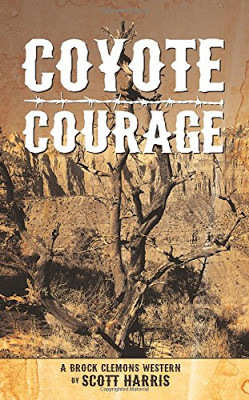
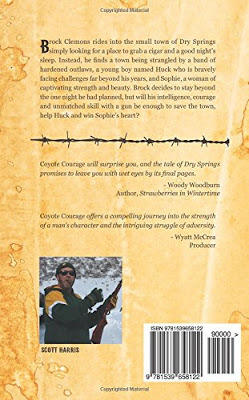 ~ WRITERS ON BOOKS: SCOTT HARRIS ~
~ WRITERS ON BOOKS: SCOTT HARRIS ~ Writer Scott Harris is beginning to make his mark in the western genre with his Brock Clemons series. His new novel, Coyote Courage, is a classic six-guns blazing oater with a Louis L’Amour pedigree. It’s a 2017 must read for any western fan. Readers can also look forward to more western adventures from Scott featuring Brock Clemons. As part of an ongoing series of blog posts, I’ve asked Scott to give us a personal look into what writers read and what books influence their lives.
Writer Scott Harris is beginning to make his mark in the western genre with his Brock Clemons series. His new novel, Coyote Courage, is a classic six-guns blazing oater with a Louis L’Amour pedigree. It’s a 2017 must read for any western fan. Readers can also look forward to more western adventures from Scott featuring Brock Clemons. As part of an ongoing series of blog posts, I’ve asked Scott to give us a personal look into what writers read and what books influence their lives. THE BOOK YOU LOVED AS A CHILD…
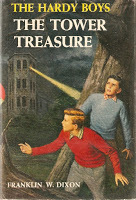 The first books I remember loving were from the 3rdgrade; The Hardy Boys. I read all of the “Original 58” (albeit the watered-down versions, since it was post 1959), which I checked out from the Bookmobile, which would visit Fulton Elementary School once a week. I won an award for reading the most books that year and fell in love with reading.
The first books I remember loving were from the 3rdgrade; The Hardy Boys. I read all of the “Original 58” (albeit the watered-down versions, since it was post 1959), which I checked out from the Bookmobile, which would visit Fulton Elementary School once a week. I won an award for reading the most books that year and fell in love with reading.In high school, I was a fan of Twain and Steinbeck, the original three Dune books and the Foundation Trilogy. But the one with greatest impact was J.R.R. Tolkein’s Lord of the Rings. For close to thirty years, my Christmas present to myself was to reread it over the holidays.
A BOOK YOU WOULD READ TO YOUR KIDS…
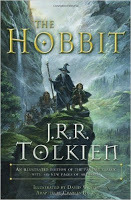 The Hobbit, again by J.R.R. Tolkein. I read it to both kids while they were still in the womb. I would lie on my wife’s stomach and read a couple of pages every night. Tolkein wrote it to be read aloud and it is a true joy to do so. I read it to them again, multiple times, as they grew up. If they had the time (they’re now 32 and 27), I’d read it to them now.
The Hobbit, again by J.R.R. Tolkein. I read it to both kids while they were still in the womb. I would lie on my wife’s stomach and read a couple of pages every night. Tolkein wrote it to be read aloud and it is a true joy to do so. I read it to them again, multiple times, as they grew up. If they had the time (they’re now 32 and 27), I’d read it to them now.THE BOOK THAT MADE YOU WANT TO BE A WRITER…
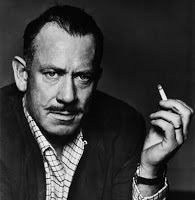 Of Mice and Men. The truth is, I could have picked almost anything from Twain or Steinbeck. Both have touched my soul, over and over again. The combination of the insight into people, the fact that both were clearly brilliant philosophers and the remarkable writing keeps me coming back.
Of Mice and Men. The truth is, I could have picked almost anything from Twain or Steinbeck. Both have touched my soul, over and over again. The combination of the insight into people, the fact that both were clearly brilliant philosophers and the remarkable writing keeps me coming back. YOUR FAVORITE CLASSIC…
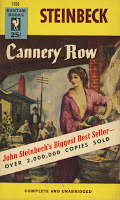 I will have to go with two; Steinbeck’s’ Cannery Row and Twains’ Huckleberry Finn. Huck Finn is the runaway favorite from Twain, but from Steinbeck, I could have just as easily picked Grapes of Wrath, East of Eden, or any number of others. I don’t know how many times I will reread their books before I tire of them, but I am not even close yet.
I will have to go with two; Steinbeck’s’ Cannery Row and Twains’ Huckleberry Finn. Huck Finn is the runaway favorite from Twain, but from Steinbeck, I could have just as easily picked Grapes of Wrath, East of Eden, or any number of others. I don’t know how many times I will reread their books before I tire of them, but I am not even close yet.THE CLASSIC YOU’VE NEVER BEEN ABLE TO READ…
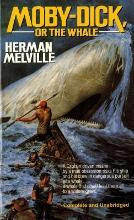 If I’d been asked this a few years ago, the answer would have been Moby Dick. I probably started it 4-5 times without ever getting through it. Eventually, I committed to reading it, and it still took me almost two years. Some of the writing was almost impossibly good and I reread some passages over and over. However, at the risk of being cast aside as a poser by serious readers, I just didn’t think it was that great. Kind of like not liking Citizen Kane. I get it, but there you go. I guess the next one I’ll try again would be War and Peace
If I’d been asked this a few years ago, the answer would have been Moby Dick. I probably started it 4-5 times without ever getting through it. Eventually, I committed to reading it, and it still took me almost two years. Some of the writing was almost impossibly good and I reread some passages over and over. However, at the risk of being cast aside as a poser by serious readers, I just didn’t think it was that great. Kind of like not liking Citizen Kane. I get it, but there you go. I guess the next one I’ll try again would be War and PeaceTHE CLASSIC YOU’VE PRETENDED TO HAVE READ…
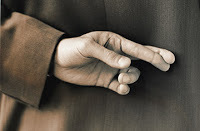 Haven’t done that yet! Haven’t Done That yet!! HAVEN’T DONE THAT YET!!! I have been told by a brilliant former LAPD detective and expert interrogator that when someone is telling the truth in denying an accusation, their denials will become louder and more emphatic. This is me following his advice.
Haven’t done that yet! Haven’t Done That yet!! HAVEN’T DONE THAT YET!!! I have been told by a brilliant former LAPD detective and expert interrogator that when someone is telling the truth in denying an accusation, their denials will become louder and more emphatic. This is me following his advice.THE MOVIE ADAPTATION YOU’VE LOVED…
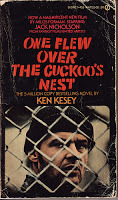 One Flew Over the Cuckoo’s Nest. Nice combination of a brilliant book and movie. As I write this, it strikes me a great evening would be had by gathering up five friends, with three of us preferring the book and the other three preferring the movie, and debating who’s right and why. BTW–I’d have to go with the movie. Why? Jack! End of debate.
One Flew Over the Cuckoo’s Nest. Nice combination of a brilliant book and movie. As I write this, it strikes me a great evening would be had by gathering up five friends, with three of us preferring the book and the other three preferring the movie, and debating who’s right and why. BTW–I’d have to go with the movie. Why? Jack! End of debate.THE BOOK YOU’D LIKE TO SEE AS A MOVIE…
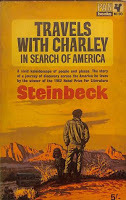 Travels with Charley, not surprisingly, by John Steinbeck. From the moment, I read it, my life was changed. I took off with my new bride shortly after reading it for the first time, and we did a 6-month road trip. We’ve been doing them ever since and it’s coming up on 40 years.
Travels with Charley, not surprisingly, by John Steinbeck. From the moment, I read it, my life was changed. I took off with my new bride shortly after reading it for the first time, and we did a 6-month road trip. We’ve been doing them ever since and it’s coming up on 40 years. There is a new novel I’ve been hearing a lot about however that might make the list; Coyote Courage. I’ve been told it would make an amazing movie, so I’m hoping to see it happen. Of course, I’ve also been told the author is charming and handsome...
THE IMAGINARY PLACE WHERE YOU COULD LIVE…
Middle Earth. If you read—and loved—Lord of the Rings, it would be hard to pick anywhere else.
THE GENRE YOU’D READ IF YOU WERE LIMITED TO ONE…
History. If it was just for pure fun, it would be westerns, but when limited to a single genre forever, it came down to two; philosophy and history. I spent 10 years studying the great Greek philosophers and hope enough stuck with me to not regret my choice. History, when well-written, contains enough philosophy and is so rich and full in context, I could see being content reading nothing else.
THE BOOK YOU’VE RETURNED TO AGAIN AND AGAIN…
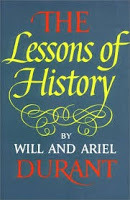 John Steinbecks’ Travels with Charley and Will and Ariel Durants’ The Lessons of History. There are several books I turn to again and again, but these are the two I make sure to read every year. Travels with Charley still fires my imagine and I can’t get past the opening passages where Steinbeck describes wanderlust without wanting to hit the road. And the Durants, in boiling down their 17-volume Story of Civilization into 100 pages, almost perfectly capturing / explaining / informing my views on mankind, make it mandatory rereading.
John Steinbecks’ Travels with Charley and Will and Ariel Durants’ The Lessons of History. There are several books I turn to again and again, but these are the two I make sure to read every year. Travels with Charley still fires my imagine and I can’t get past the opening passages where Steinbeck describes wanderlust without wanting to hit the road. And the Durants, in boiling down their 17-volume Story of Civilization into 100 pages, almost perfectly capturing / explaining / informing my views on mankind, make it mandatory rereading.THE FICTIONAL FRIENDS YOU’D LOVE TO HAVE…
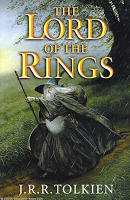 Not surprisingly, they come from my favorite books, which is probably why they are my favorite books. I would love to have almost all of the “Nine” from Lord of the Rings as friends. Perhaps their collective title of the Fellowship of the Ring describes why. What boy, of any age, wouldn’t want Huck Finn to be his friend, or to be Huck Finn. And Mack, leader of the bums in Cannery Row, is a man with whom I would love to spend a week, or a lifetime.
Not surprisingly, they come from my favorite books, which is probably why they are my favorite books. I would love to have almost all of the “Nine” from Lord of the Rings as friends. Perhaps their collective title of the Fellowship of the Ring describes why. What boy, of any age, wouldn’t want Huck Finn to be his friend, or to be Huck Finn. And Mack, leader of the bums in Cannery Row, is a man with whom I would love to spend a week, or a lifetime.THE LAST NOVEL TO MAKE YOU LAUGH AND THE LAST TO MAKE YOU CRY…
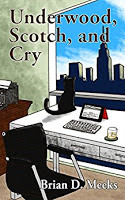 Underwood, Scotch and Cry (Brian Meeks) made me laugh. A little-known author, but good insight into people and has a subtle, but biting sense of humor I find irresistible. And having just finished rereading (1st time since high school) Diary of a Young Girl (Anne Frank), it would be almost impossible not to cry.
Underwood, Scotch and Cry (Brian Meeks) made me laugh. A little-known author, but good insight into people and has a subtle, but biting sense of humor I find irresistible. And having just finished rereading (1st time since high school) Diary of a Young Girl (Anne Frank), it would be almost impossible not to cry.WHAT YOU’RE READING NOW…
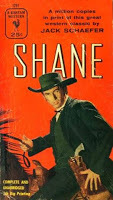 Shane (Jack Schaefer), for a project I’m working on. Fargo #4 and #5, because I’ve only recently discovered John Benteen and now I’m chewing them up / The Civil War (Shelby Foote), because I organized a monthly discussion group about the Civil War / Croaker: Kill me Again (Paul Bishop), because I enjoy discovering and reading great authors.
Shane (Jack Schaefer), for a project I’m working on. Fargo #4 and #5, because I’ve only recently discovered John Benteen and now I’m chewing them up / The Civil War (Shelby Foote), because I organized a monthly discussion group about the Civil War / Croaker: Kill me Again (Paul Bishop), because I enjoy discovering and reading great authors.  COYOTE COURAGE
COYOTE COURAGEBrock Clemons rides into the small town of Dry Springs simply looking for a place to grab a cigar and a good night’s sleep. Instead, he finds a town being strangled by a band of hardened outlaws, a young boy named Huck who is bravely facing challenges far beyond his years, and Sophie, a woman of captivating strength and beauty. Brock decides to stay beyond the one night he had planned, but will his intelligence, courage and unmatched skill with a gun be enough to save the town, help Huck and win Sophie’s heart?
Published on January 30, 2017 11:00
January 25, 2017
CONFESSIONS FROM THE DARK STREETS
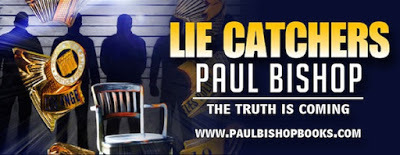 CONFESSIONS FROM THE DARK STREETS Of the fifteen books I’ve written, my latest novel,
Lie Catchers
,is the most personal and unique. Having spent thirty-five years with the LAPD and thirty years as a professional writer, I am a sturdy branch on the genealogy tree of police writers. Other cop-author branches on the tree include William Caunitz (NYPD), Joseph McNamara (San Jose PD), Sonny Grosso (NYPD), and a plethora of others (for a full list
CLICK HERE
). The LAPD, however, has always led the way when it comes to police writers, including such luminaries as Dallas Barnes,
Kathy Bennett
, Gene Roddenberry (yes, that Gene Roddenberry), and almost 100 others (
CLICK HERE
). LAPD, of course, was also where the heavyweight champ of police writers, Joseph Wambaugh, hung his shoulder holster. With that kind of professional ancestry, it was pretty much a given I would also do a Wambaugh when it came to writing novels. I have written books in other genres, westerns, an Elvis-is-not–dead novel, soccer mysteries, and boxing noirs, but cop dramas have always constituted the largest part of my output.
CONFESSIONS FROM THE DARK STREETS Of the fifteen books I’ve written, my latest novel,
Lie Catchers
,is the most personal and unique. Having spent thirty-five years with the LAPD and thirty years as a professional writer, I am a sturdy branch on the genealogy tree of police writers. Other cop-author branches on the tree include William Caunitz (NYPD), Joseph McNamara (San Jose PD), Sonny Grosso (NYPD), and a plethora of others (for a full list
CLICK HERE
). The LAPD, however, has always led the way when it comes to police writers, including such luminaries as Dallas Barnes,
Kathy Bennett
, Gene Roddenberry (yes, that Gene Roddenberry), and almost 100 others (
CLICK HERE
). LAPD, of course, was also where the heavyweight champ of police writers, Joseph Wambaugh, hung his shoulder holster. With that kind of professional ancestry, it was pretty much a given I would also do a Wambaugh when it came to writing novels. I have written books in other genres, westerns, an Elvis-is-not–dead novel, soccer mysteries, and boxing noirs, but cop dramas have always constituted the largest part of my output.
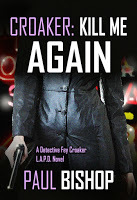 Fey Croaker, the heroine of the five book series in which she is featured, is a unique character, but the novels themselves follow the traditional sequence of mystery or police procedurals – there’s a murder, it’s a whodunit, the quirky detective doggedly works to untangle the morass of red herrings and false clues and, eventually, slaps the cuffs on the perpetrator. This is not a bad thing, but I wanted Lie Catchers to be something more. I wanted to take the reader into a world they only thought they knew and turn them on their heads. During my LAPD career, I spent over twenty-five years investigating sex crimes. For fifteen of those years, I ran the Operations West Bureau–Sexual Assault Detail (OWB-SAD) – a unit of thirty detectives investigating all sex crimes in an area covering twenty-five percent of the city. This extensive jurisdiction included Hollywood Area, where anything that could happen sexually usually did. From its formation, OWB-SAD consistently maintained the highest sex crimes clearance rate and number of detective initiated arrests in the city. We were busy, but what made us far more successful than the other sex crimes details in the city was our attention to interrogations. Every interrogation we did was videotaped, reviewed, and critiqued. We developed many different techniques, both in the box and on the streets. Our byword was the belief the interrogation room wasn’t a place, it was wherever an OWB-SAD detective happened to be – the suspect’s home or workplace, in a car, in a coffee shop, literally anywhere. This was interrogation as it had never been approached before. For good detectives, it’s not the cases we crack that matter, it’s the ones we don’t that haunt us. I now teach week-long interrogation classes to experienced detectives at wide variety of law enforcement agencies. Invariably, several detectives in the class have an epiphany. They think back to a case where they couldn’t get to the truth and realize they could have done so if they’d had these types of techniques – which are all part of a tactical approach to interrogation. As a novelist, I finally had my own interrogation epiphany. I realized, I’d never seen or read anything dealing with interrogation in a realistic manner. Books don’t get it right. Movies and TV certainly don’t get it right – not even the real cop shows like 48 Hours. However, with my background and experiences, I was in a unique position to write an interrogation themed novel and make it as realistic as fiction would allow. Lie Catchersis the result. I didn’t want Lie Catchersto be just another whodunit murder mystery. I wanted to give the reader an intimate experience – much like the world created between a detective and a suspect in the box. To accomplish that goal, I knew the third personnarrative voice I’d used for the Fey Croaker novels would not work. For Lie Catchers, I had to get inside the head of one of the main characters and tell the story in the first person.
Fey Croaker, the heroine of the five book series in which she is featured, is a unique character, but the novels themselves follow the traditional sequence of mystery or police procedurals – there’s a murder, it’s a whodunit, the quirky detective doggedly works to untangle the morass of red herrings and false clues and, eventually, slaps the cuffs on the perpetrator. This is not a bad thing, but I wanted Lie Catchers to be something more. I wanted to take the reader into a world they only thought they knew and turn them on their heads. During my LAPD career, I spent over twenty-five years investigating sex crimes. For fifteen of those years, I ran the Operations West Bureau–Sexual Assault Detail (OWB-SAD) – a unit of thirty detectives investigating all sex crimes in an area covering twenty-five percent of the city. This extensive jurisdiction included Hollywood Area, where anything that could happen sexually usually did. From its formation, OWB-SAD consistently maintained the highest sex crimes clearance rate and number of detective initiated arrests in the city. We were busy, but what made us far more successful than the other sex crimes details in the city was our attention to interrogations. Every interrogation we did was videotaped, reviewed, and critiqued. We developed many different techniques, both in the box and on the streets. Our byword was the belief the interrogation room wasn’t a place, it was wherever an OWB-SAD detective happened to be – the suspect’s home or workplace, in a car, in a coffee shop, literally anywhere. This was interrogation as it had never been approached before. For good detectives, it’s not the cases we crack that matter, it’s the ones we don’t that haunt us. I now teach week-long interrogation classes to experienced detectives at wide variety of law enforcement agencies. Invariably, several detectives in the class have an epiphany. They think back to a case where they couldn’t get to the truth and realize they could have done so if they’d had these types of techniques – which are all part of a tactical approach to interrogation. As a novelist, I finally had my own interrogation epiphany. I realized, I’d never seen or read anything dealing with interrogation in a realistic manner. Books don’t get it right. Movies and TV certainly don’t get it right – not even the real cop shows like 48 Hours. However, with my background and experiences, I was in a unique position to write an interrogation themed novel and make it as realistic as fiction would allow. Lie Catchersis the result. I didn’t want Lie Catchersto be just another whodunit murder mystery. I wanted to give the reader an intimate experience – much like the world created between a detective and a suspect in the box. To accomplish that goal, I knew the third personnarrative voice I’d used for the Fey Croaker novels would not work. For Lie Catchers, I had to get inside the head of one of the main characters and tell the story in the first person.
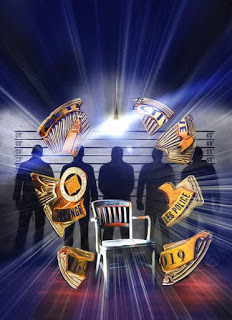 ORIGINAL COVER ART
ORIGINAL COVER ART JOSEPH HAYESLie Catchersfeatures two top LAPD interrogators, Ray Pagan and Calamity Jane Randall. Telling the story from Ray Pagan’s perspective just didn’t feel right. One of Pagan’s qualities is the unusual ways in which he approaches situations. This was best experienced from the point of view of another character who would come to understand Pagan along with the reader. This put me, as the writer, inside the head of Calamity Jane Randall – a very good detective, but still a woman who doesn’t truly understand herself. To become a great detective, a great interrogator, she needs Pagan to lead her on the path to self-discovery. However, Pagan also needs Randall – for many reason, which become clear in the narrative, but most of all to save him from himself.
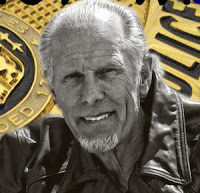 I didn’t want Pagan and Randall simply to be a riff on Holmes and Watson. I wanted their dynamic to be an equal partnership. Randall isn’t just there to assist and marvel at Pagan’s brilliance – a foil used to listen while Pagan explained his cleverness. Randall is her own woman with her own strengths. Yes, sometimes Pagan acts as a mentor, but I wanted there to be an equal number of times when Randall’s actions saved the day. Jane was a leader, not just a follower. But here was the challenge. As a male, writing in the third person about a female main character like Fey Croaker was one thing. Actually getting inside Jane Randall’s head to tell the story from her perspective as a woman was entirely another. I had been living with the characters of Pagan and Randall in my brain for quite a while before I started writing Lie Catchers. As I prepared to start tapping out words, I was surprised to find I actually knew more about Jane than I did about Pagan. Jane was a touch more tentative, a little less self-aware, than Fey Croaker. She was no less of a detective, but her approach was much more stealthy. Fey reacts, charging into situations until she crushed them. Jane quickly assesses situations and responds – achieving her goal with a minimum of shattered glass. Interrogation is all about becoming the person the suspect needs you to be in order to confess. You can’t do that by reacting…You have to be able to respond. Jane’s style complimented the skills she needed to become a great interrogator.
I didn’t want Pagan and Randall simply to be a riff on Holmes and Watson. I wanted their dynamic to be an equal partnership. Randall isn’t just there to assist and marvel at Pagan’s brilliance – a foil used to listen while Pagan explained his cleverness. Randall is her own woman with her own strengths. Yes, sometimes Pagan acts as a mentor, but I wanted there to be an equal number of times when Randall’s actions saved the day. Jane was a leader, not just a follower. But here was the challenge. As a male, writing in the third person about a female main character like Fey Croaker was one thing. Actually getting inside Jane Randall’s head to tell the story from her perspective as a woman was entirely another. I had been living with the characters of Pagan and Randall in my brain for quite a while before I started writing Lie Catchers. As I prepared to start tapping out words, I was surprised to find I actually knew more about Jane than I did about Pagan. Jane was a touch more tentative, a little less self-aware, than Fey Croaker. She was no less of a detective, but her approach was much more stealthy. Fey reacts, charging into situations until she crushed them. Jane quickly assesses situations and responds – achieving her goal with a minimum of shattered glass. Interrogation is all about becoming the person the suspect needs you to be in order to confess. You can’t do that by reacting…You have to be able to respond. Jane’s style complimented the skills she needed to become a great interrogator.Jane also needed to tell her story, her way. Unless you are a writer, you can’t understand the joy and the amazement of experiencing a fictional character completely taking over your narrative. It is as if they are an entity inside you, knowing all your secrets, each skeleton in your closet. Every day, they force you to sit down at the keyboard and then take charge of your fingers to tap out their story in staccato bursts of channeled energy. Through this process, Lie Catchers became something more than just a story. It became an experience. All of the interrogation techniques within the pages are as real as I could make them, but the emotions and intensity – the intimacy I wanted to establish between characters and readers – were all sparked by Jane Randall and Ray Pagan. My name is on the cover of Lie Catchers, but it’s Randall and Pagan’s story. They are your personal guides into the continent of darkness which lies in the soul of the art of interrogation. You couldn’t be in better hands.
Published on January 25, 2017 19:51
January 24, 2017
KICKING AND SCREAMING
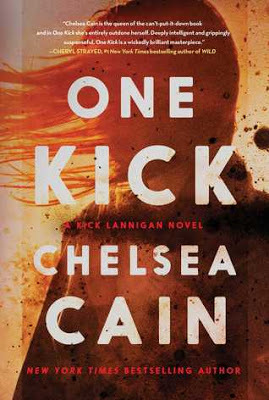 KICKING AND SCREAMING In the Men’s Adventure Paperbacks of the 70s and 80s Facebook group (the best place on FB to hang out ever), we usually share weekly what we are reading, even if it doesn't pertain to the group's main focus. Recently, I posted I was finishing up One Kick by Chelsea Cain judging it as very good. Surprisingly, this elicited almost instantaneous negative responses. told how horrible, unsympathetic, and icky the twenty-one year old female character was. I was also told I must be the only person who liked the book because it had been such a flop the publisher had cancelled the second book even though they had paid for it. And all of this came from as nice a group of knowledgeable, generous guys you could want to hang out with.
KICKING AND SCREAMING In the Men’s Adventure Paperbacks of the 70s and 80s Facebook group (the best place on FB to hang out ever), we usually share weekly what we are reading, even if it doesn't pertain to the group's main focus. Recently, I posted I was finishing up One Kick by Chelsea Cain judging it as very good. Surprisingly, this elicited almost instantaneous negative responses. told how horrible, unsympathetic, and icky the twenty-one year old female character was. I was also told I must be the only person who liked the book because it had been such a flop the publisher had cancelled the second book even though they had paid for it. And all of this came from as nice a group of knowledgeable, generous guys you could want to hang out with.
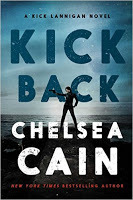 (Note:
For the record, the real reason behind the second book not appearing is far more complicated, including the author following her editor from one major legacy publisher to another leaving the follow up book, Kick Back, in limbo with the original publisher, who was clearly upset by the editor and author defection.) There are plenty of five star reviews for One Kick on Amazon, and an overall average of four stars for all reviews. However, there are a surprising number of one star reviews in the mix. These reflect the same sentiments I received when I mentioned reading the book—Sick... Cringe inducing... Do not read… It’s awful... Extremely disturbing... Unlikable protagonist and unbelievable story... Unless your world is enjoyed in a state of perpetual ineffectual fear and loathing, don't bother... Even One Kick author, Chelsea Cain, has lamented on her Facebook page over how the book was received and the lack of understanding many readers showed toward the main character, Kick Lannigan.
(Note:
For the record, the real reason behind the second book not appearing is far more complicated, including the author following her editor from one major legacy publisher to another leaving the follow up book, Kick Back, in limbo with the original publisher, who was clearly upset by the editor and author defection.) There are plenty of five star reviews for One Kick on Amazon, and an overall average of four stars for all reviews. However, there are a surprising number of one star reviews in the mix. These reflect the same sentiments I received when I mentioned reading the book—Sick... Cringe inducing... Do not read… It’s awful... Extremely disturbing... Unlikable protagonist and unbelievable story... Unless your world is enjoyed in a state of perpetual ineffectual fear and loathing, don't bother... Even One Kick author, Chelsea Cain, has lamented on her Facebook page over how the book was received and the lack of understanding many readers showed toward the main character, Kick Lannigan.
 I nearly cracked from the pressure. Like serious Judy Garland level mental breakdown. When celebrities announce that they are being treated for "exhaustion"—I get that now. But it was the best thing that could have happened, as trite as that sounds, because it forced me to make changes in my professional life and set some boundaries and get back to what this is all about, writing. Anyone crazy enough to write a book is, after all, crazy. The trick is staying functional enough to do the work, because it's the work that keeps me sane. That sometimes creates an interesting loop. Cain is well established on the thriller front. She has had six previous novels on the New York Timesbestseller list, been published in twenty-four languages, recommended on the Today show, appeared in episodes of HBO’s True Blood and ABC’s Castle, and included in NPR’s list of the top 100 thrillers ever written. She has also weathered sustained Twitter attacks of a viperous nature over her outspoken feminist stance regarding women working in comic books (she is the writer of the Marvel female superhero Mockingbird)—The girl ain’t no newbie. All of this experience, yet somehow, One Kick elicited a deeply polarizing reaction. The question then is why. However, to find the answer, we have to begin by looking at the premise of the novel: Meet Kick Lannigan: famously kidnapped at age six, Kick captured America’s hearts when she was rescued five years later. Trained as a marksman, lock picker, escape artist and bomb maker by her abductor, Kick continues to expand her strange skill set after her release: mastering martial arts, boxing, knife throwing, and host of other talents—all part of training herself to be safe. Imagine if Elizabeth Smart had become a mercenary. Now twenty-one, irrevocably scarred yet determined to never be a victim again, she is approached by an enigmatic and wealthy former weapons dealer named John Bishop. Bishop uses his fortune and contacts to track down missing children. He wants Kick to help him and he won’t take no for an answer—Yet everything he tells her about himself seems to be a lie. With lives hanging in the balance, Kick is set to be the crusader she has always imagined herself. Little does she know the answers she and Bishop seek are hidden in one of the few places she doesn’t want to navigate—the dark corners of her own mind.
I nearly cracked from the pressure. Like serious Judy Garland level mental breakdown. When celebrities announce that they are being treated for "exhaustion"—I get that now. But it was the best thing that could have happened, as trite as that sounds, because it forced me to make changes in my professional life and set some boundaries and get back to what this is all about, writing. Anyone crazy enough to write a book is, after all, crazy. The trick is staying functional enough to do the work, because it's the work that keeps me sane. That sometimes creates an interesting loop. Cain is well established on the thriller front. She has had six previous novels on the New York Timesbestseller list, been published in twenty-four languages, recommended on the Today show, appeared in episodes of HBO’s True Blood and ABC’s Castle, and included in NPR’s list of the top 100 thrillers ever written. She has also weathered sustained Twitter attacks of a viperous nature over her outspoken feminist stance regarding women working in comic books (she is the writer of the Marvel female superhero Mockingbird)—The girl ain’t no newbie. All of this experience, yet somehow, One Kick elicited a deeply polarizing reaction. The question then is why. However, to find the answer, we have to begin by looking at the premise of the novel: Meet Kick Lannigan: famously kidnapped at age six, Kick captured America’s hearts when she was rescued five years later. Trained as a marksman, lock picker, escape artist and bomb maker by her abductor, Kick continues to expand her strange skill set after her release: mastering martial arts, boxing, knife throwing, and host of other talents—all part of training herself to be safe. Imagine if Elizabeth Smart had become a mercenary. Now twenty-one, irrevocably scarred yet determined to never be a victim again, she is approached by an enigmatic and wealthy former weapons dealer named John Bishop. Bishop uses his fortune and contacts to track down missing children. He wants Kick to help him and he won’t take no for an answer—Yet everything he tells her about himself seems to be a lie. With lives hanging in the balance, Kick is set to be the crusader she has always imagined herself. Little does she know the answers she and Bishop seek are hidden in one of the few places she doesn’t want to navigate—the dark corners of her own mind.
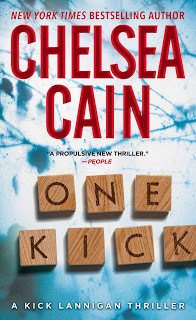 Sounds exciting, doesn’t it? So, what’s the problem. The answer lies in the fact, Cain did not deliver the book readers were expecting based on the cover synopsis. Cain had done her research too well. She understood victims who have endured the sexual abuse described (more implied than overt) as happening to Kick between the ages of six and eleven irrevocably changes an individual—forever. There is no going back. Instead of giving readers the expected sympathetic, yet strong, vengeance seeking hero, Cain chose to treat her character with an understanding of the constantly shifting, unstable, misleading sands of the mind left behind by this kind of experience. Kick Lannigan wants to believe she is strong. She wants to believe she can obsessively train herself in all the defensive arts in order to control the world around her and protect herself and those few similarly broken birds she cares about. Perhaps in wish fulfillment fiction this would be the path the protagonist would follow on the way to healing and reintegration...But not in the real world...Never in the real world. Cain understands this and treats her hero with the respect she deserves. Kit Lannigan is broken. The pieces of her shattered by her experiences may have been gathered together, but like Humpty Dumpty, all the kings horse and all the king’s men don’t stand a chance of putting Kick back together again. How do I know this? I spent over thirty years of my law enforcement career trying to put together again the Kick Lannigans of the real world, when the only thing you can hope for is a modicum of empty justice. I have sat with the abusers, not across a table like you’ve seen on every television show cop show ever, but up close—close enough physically and mentally to reach in and access their dark places. I know the madness there. I know the damage the madness wreaks. And I know, Cain got it as close to right as I’ve ever come across in fiction. Kit Lannigan is a mess. She is unlikable. She can be cringe inducing. Her behavior is extremely disturbing. She does live in a state of perpetual ineffectual fear and loathing. She epitomizes icky. She dissociates between the personality she was before the kidnapping, the personality she was during the years she was missing, abused, and molested, and the personality now she has been returned to the normal world. She obsessively trains to protect herself, she has killer skills, yet when the time to use them comes she freezes. No matter how hard she tries, she can’t break to emotional and mental bond burned into her by her abuser. She is indelibly and always linked to him—forever. Those who are supposed to protect her failed, and now those same people are failing her again—especially her celebrity seeking mother who is a nightmare of a sociopathic narcissist in her own right. And kids are still being taken—every day—and Kick knows exactly what they are going through and it tears her apart in obsessive frenzy. The films of her being molested as a child are still making the rounds of the internet porn sites and have made her an unwilling celebrity of the worst kind. They will forever be out there, and by law, she gets notified every time law enforcement recovers a download on a pedophile’s computer. And worst of all, she knows exactly what every pedophile who views her films is thinking and fantasizing about doing to her. It’s all ugly. Very ugly. Unfortunatley, it is also the sordid reality for those who are victims of long term sexual abuse—especially at a young age. For a fictional character, Kick Lannigan is as close to real as it gets. I’ve met her. Many times. Cain has my respect and should be applauded—not reviled—for not shying away from the inconvenient truth of the damage from which victims of this type of abuse never fully recover—not even close. And therein lies the problem. Readers don’t want real. They want escapisim. They don’t want to look into the hearts of real monsters—those who lurk in the darkness of the world and those who lie in wait in the darkness of the mind. Imaginary serial killers in the pages of a book are nothing more than Halloween haunts compared to the real thing. They always get caught and they always get their comeuppance. They allow the reader to feel the vicarious scares from the safe distance of their proverbial armchairs. Real serial killers, real rapists and serial sexual abusers of children, are terrifying in their warped sordidness. Pray you or a child you love never end up in their hands.
Sounds exciting, doesn’t it? So, what’s the problem. The answer lies in the fact, Cain did not deliver the book readers were expecting based on the cover synopsis. Cain had done her research too well. She understood victims who have endured the sexual abuse described (more implied than overt) as happening to Kick between the ages of six and eleven irrevocably changes an individual—forever. There is no going back. Instead of giving readers the expected sympathetic, yet strong, vengeance seeking hero, Cain chose to treat her character with an understanding of the constantly shifting, unstable, misleading sands of the mind left behind by this kind of experience. Kick Lannigan wants to believe she is strong. She wants to believe she can obsessively train herself in all the defensive arts in order to control the world around her and protect herself and those few similarly broken birds she cares about. Perhaps in wish fulfillment fiction this would be the path the protagonist would follow on the way to healing and reintegration...But not in the real world...Never in the real world. Cain understands this and treats her hero with the respect she deserves. Kit Lannigan is broken. The pieces of her shattered by her experiences may have been gathered together, but like Humpty Dumpty, all the kings horse and all the king’s men don’t stand a chance of putting Kick back together again. How do I know this? I spent over thirty years of my law enforcement career trying to put together again the Kick Lannigans of the real world, when the only thing you can hope for is a modicum of empty justice. I have sat with the abusers, not across a table like you’ve seen on every television show cop show ever, but up close—close enough physically and mentally to reach in and access their dark places. I know the madness there. I know the damage the madness wreaks. And I know, Cain got it as close to right as I’ve ever come across in fiction. Kit Lannigan is a mess. She is unlikable. She can be cringe inducing. Her behavior is extremely disturbing. She does live in a state of perpetual ineffectual fear and loathing. She epitomizes icky. She dissociates between the personality she was before the kidnapping, the personality she was during the years she was missing, abused, and molested, and the personality now she has been returned to the normal world. She obsessively trains to protect herself, she has killer skills, yet when the time to use them comes she freezes. No matter how hard she tries, she can’t break to emotional and mental bond burned into her by her abuser. She is indelibly and always linked to him—forever. Those who are supposed to protect her failed, and now those same people are failing her again—especially her celebrity seeking mother who is a nightmare of a sociopathic narcissist in her own right. And kids are still being taken—every day—and Kick knows exactly what they are going through and it tears her apart in obsessive frenzy. The films of her being molested as a child are still making the rounds of the internet porn sites and have made her an unwilling celebrity of the worst kind. They will forever be out there, and by law, she gets notified every time law enforcement recovers a download on a pedophile’s computer. And worst of all, she knows exactly what every pedophile who views her films is thinking and fantasizing about doing to her. It’s all ugly. Very ugly. Unfortunatley, it is also the sordid reality for those who are victims of long term sexual abuse—especially at a young age. For a fictional character, Kick Lannigan is as close to real as it gets. I’ve met her. Many times. Cain has my respect and should be applauded—not reviled—for not shying away from the inconvenient truth of the damage from which victims of this type of abuse never fully recover—not even close. And therein lies the problem. Readers don’t want real. They want escapisim. They don’t want to look into the hearts of real monsters—those who lurk in the darkness of the world and those who lie in wait in the darkness of the mind. Imaginary serial killers in the pages of a book are nothing more than Halloween haunts compared to the real thing. They always get caught and they always get their comeuppance. They allow the reader to feel the vicarious scares from the safe distance of their proverbial armchairs. Real serial killers, real rapists and serial sexual abusers of children, are terrifying in their warped sordidness. Pray you or a child you love never end up in their hands.
Published on January 24, 2017 22:11



